Faculty Resources
Assignments.

There are several assignments for Principles of Public Speaking. If you import this course into your learning management system (Blackboard, Canvas, etc.), the assignments will automatically be loaded into the assignment tool. They can be used as is, modified, or removed. You can preview them below:
- Assignment: Syllabus Review
- Assignment: Speech of Self-Introduction
- Assignment: Speech to Introduce a Classmate
- Assignment: Impromptu Speech
- Discussion: Speech Analysis
- Assignment: Demonstration Speech Topic Selection
- Assignment: Demonstration Speech Outline
- Discussion: Demonstration Speech Handouts and Presentations
- Assignment: Peer Evaluation of Demonstration Speech
- Assignment: Audience Analysis of an Advertisement Speech
- Assignment: Inspirational Speech
- Assignment: Persuasive Speech
- Assignment: Subject Exploration, Development, and Understanding
- Assignment: Audience Analysis for Persuasive Essay
- Assignment: Rebuttal
- Assignment: Reflection
- Assignment: Persuasive Speech Topic Outline
- Discussion: Persuasive Speech Handouts and References
- Assignment: Self-Evaluation of Demonstration Speech
- Assignment: Peer Evaluation of Persuasive Speech
- Assignment: Planning for Final Speech

Optional Extra Credit Assignments
You can assign these extra credit opportunities to your students:
Attending a Speech Outside of Class
Analyze the speech for invention, arrangement, style, memory, and delivery.
Further, look for logos, pathos, and ethos.
Write about your overall impression.
Giving a Speech Outside of Class
You can earn credit for giving a speech outside of class.
You must talk to me ahead of time to work out the details.
If you are giving the speech, I prefer that you have someone record you. Another option is to have someone from class attend and fill out a review (and you will both get credit).
Again, get prior approval. Let me know your plans.
- Assignments. Provided by : Lumen Learning. License : CC BY: Attribution
- Optional Extra Credit Assignments. Authored by : Christie Fierro and Brent Adrian. Provided by : Lumen Learning. Located at : http://lumenlearning.com/ . Project : Kaleidoscope Open Course Initiative. License : CC BY: Attribution
- Pencil Cup. Authored by : IconfactoryTeam. Provided by : Noun Project. Located at : https://thenounproject.com/term/pencil-cup/628840/ . License : CC BY: Attribution

Privacy Policy
- Games, topic printables & more
- The 4 main speech types
- Example speeches
- Commemorative
- Declamation
- Demonstration
- Informative
- Introduction
- Student Council
- Speech topics
- Poems to read aloud
- How to write a speech
- Using props/visual aids
- Acute anxiety help
- Breathing exercises
- Letting go - free e-course
- Using self-hypnosis
- Delivery overview
- 4 modes of delivery
- How to make cue cards
- How to read a speech
- 9 vocal aspects
- Vocal variety
- Diction/articulation
- Pronunciation
- Speaking rate
- How to use pauses
- Eye contact
- Body language
- Voice image
- Voice health
- Public speaking activities and games
- About me/contact
- Activities and games
- 5 fun speech games
Public Speaking Activities
5 fun speech games to build skills and confidence.
By: Susan Dugdale | Last modified: 10-26-2023
There are five public speaking activities on this page, along with numerous spinoffs.
Their principal purpose is to develop speech fluency and confidence through fun!
You'll find they are easily adaptable to groups of all ages and skill levels: from newcomers to advanced.
I've used them all and know they work. People become so enjoyably engrossed in them, they forget to be fearful!
1. Interview Introductions
Interview Introductions are a great way to break the ice with a new group of people. The exercise has them finding out about each other and then introducing the person they interviewed to the whole group.
As it's a lot less threatening or scary to talk about someone else rather than yourself, you'll find people respond really positively as they're generally eager to represent the person they interviewed well.
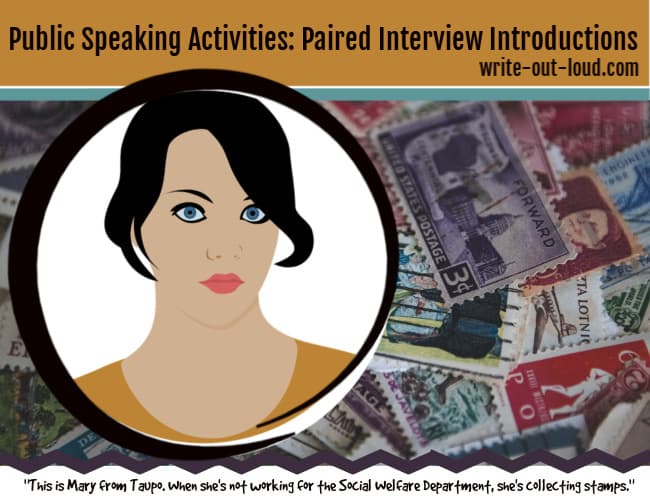
Instructions
- Divide your group into pairs.
- Each person interviews the other in turn. The information gained forms the basis of a brief introduction speech they'll give to the whole group when the interviewing process is complete.
- Ask them to find out their partner's name, where they live/work, what hobbies they have, what their favorite book, film, song...is, what they're most proud of (an achievement perhaps), what they hope for from the class, something funny that happened in their childhood, where they go for holidays, what they think about the latest local issue ... Obviously they can't expect to cover all of that in detail inside the brief time they spend talking with each other. One or two interesting points is enough!
- Establish a time limit for the interviews. I've found 10 minutes works well. Keep track of the time and call change at the halfway point, 5 minutes, to ensure both people get an opportunity to be interviewed and to interview.
- When the group comes back together the introductions begin: "This is Mary from Taupo. When she's not working for the Social Welfare Department as a community social worker she's collecting stamps. She says part of their charm is that they don't answer back and are quiet!"
2. Image Starters
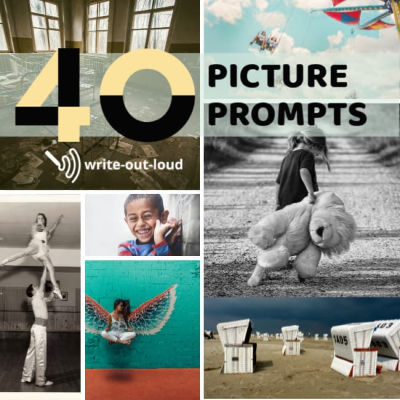
Picture prompts or image starters are great for sparking imaginative storytelling and conversations.
Either use my ready-made printable file of 40 picture prompts , (which you can find out more about by clicking the link), or gather up a collection of your own to use.
You'll need interesting images/photos from magazines or newspapers - enough for everybody to have one each and then a few spare.
Place them face down and have everybody pick one.
Using the image as a prompt, what can they share about it?
Questions to get started are:
- Where is this photo/image from? (And the answer doesn't have to be true - merely plausible! Encourage imaginative creativity.)
- What's happening in this photo/picture?
- What feelings does the image evoke?
- Is there a season or time associated with it?
- What happened after or before the photo was taken?
5 activities using image starters
If you'd like specific instructions for five different activities based around images you'll find them here: picture prompts for impromptu speeches .
They range from introductory 'show and tell', like the starter questions above, to more advanced. There are solo as well as group activities.
3. For and Against

'For and Against' encourages flexibility: the ability to see a topic from opposing sides.
A speaker has 30 seconds to talk 'for' a topic and then another 30 seconds to speak 'against' it.
Prepare and print out a selection of controversial speech topics. You'll need one per person.
Put the topics into a non-see through bag. Have each speaker select their topic when it's their turn to speak.
Ideally what's wanted is at least two or three good points supporting both sides: for and against.
Time the speech. Call start, the half way point and, stop.
Sample topics:
- money is the root of all evil
- a country gets the government it deserves
- ' green ' politics are just the current fashion
- pets in apartments should be banned
- marriage is essentially a business contract
- 'Religion is the opiate of the masses' : Karl Marx
- poverty is a state of mind
- euthanasia is unjustifiable
- global warming is media hype
- cloning animals should be banned
- animal testing is immoral
For variation split your group into pairs and extend the time limit to 1 - 2 minutes. One person takes the 'for' position, and other takes the 'against'.
More 1 minute speech practice
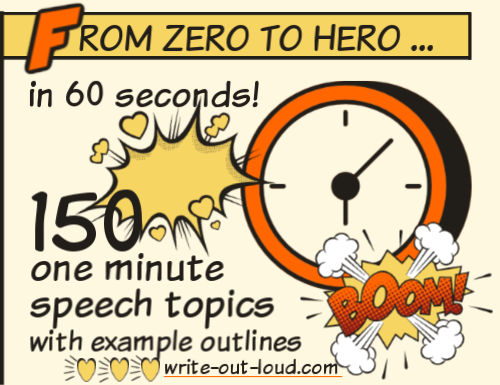
For 150 1 minute speech topics with 3 example speech outlines following the PREP (Point, Reason, Example, Point) format, the full text of three speeches plus audio, visit: 1 minute speech topics .
Get instant organizers for impromptu speeches
For more on structuring impromptu speeches quickly and effectively go to impromptu speaking templates . You'll find 7 useful speech outline organizers explained (including PREP), alongside suggestions to banish impromptu speaking blues.
4. The Object of my Affection

Gather up a collection of small objects, enough for one per speaker. For example: a vintage toy car, a can of sardines, a hair ribbon, an old black and white photographic portrait, a pair of baby shoes ....
Put all of them into a non-see through bag.
Each speaker puts their hand into the bag and pulls out an object. Whatever they get forms the basis of their 1 - 2 minute speech.
Ideas to help the speakers get started:
- This ... { insert the name of whatever it is the speaker has in their hand } saved my life. It happened like this...
- Whenever I see a ...{ insert the name of whatever it is the speaker has in their hand } it reminds me of the time I...
- I collect ...{i nsert the name of whatever it is the speaker has in their hand } and this one is the prize of my collection. It used to belong to ...
5. Conducted Speech
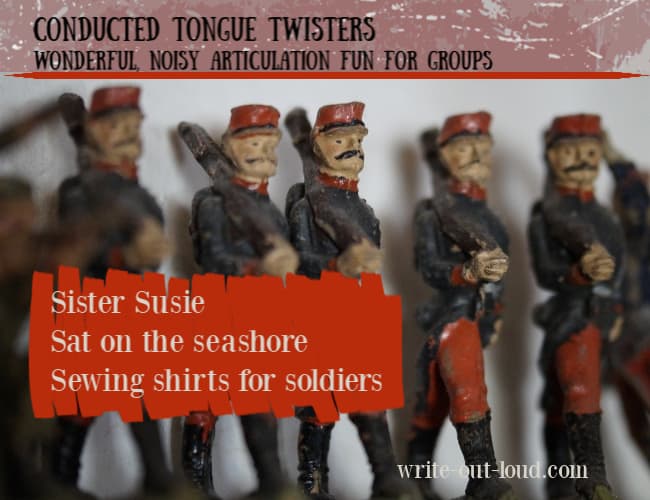
This is a group public speaking activity. It is noisy, effective and outrageously good fun!
Select a tongue twister from this page of diction exercises eg. " Sister Susie sat on the seashore sewing shirts for soldiers ".
Divide your class into groups of four. Three in each group will be the speakers and the fourth, the conductor.
The speakers repeat the tongue twister responding to the conductor's direction. He/she can make them go faster or slower, louder or quieter. The conductor could even decide to make it a round by staggering when each person begins!
The goal of the exercise is to practice articulation coupled with vocal variety ie. speech rate and volume.
It also teaches cooperation and focus, or concentration. Let your mind wander, and it's game over! You've lost it, not only for yourself but your group as well.
Swap the conductor role around to give everybody a turn.
Once everybody is familiar with the activity, give the groups turns at demonstrating their prowess to the whole class. They'll love seeing and hearing each other perform. ☺
If you liked these speech activities ...
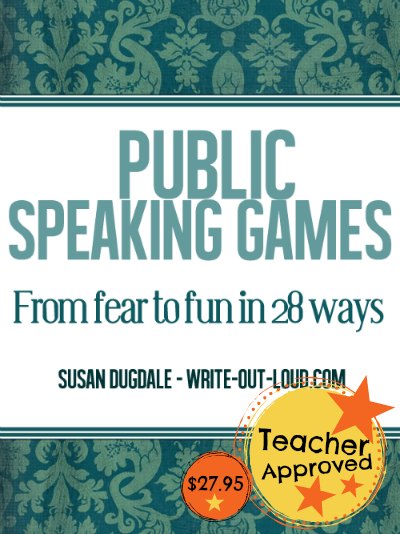
You'll love my ebook!
28 public speaking games (with many more variations and extensions), full instructions, PLUS printable topic, tongue twister, poem and image sheets.
A complete one-stop-select-print-go public speaking resource for busy people.
Find out more >>
For more freebie public speaking activities:
- 10 activities for public speaking - a collection of tried and tested speech class activities for middle school upwards
- Another 7 fun-filled public speaking games for groups
- Improv games - a collection of 5 excellent drama games for groups
- Public speaking exercises - these focus on the individual speaker- how to breathe well, stand, use eye contact effectively...
What's the difference between these freebie activities and your ebook?
My ebook contains the best of all the games from these pages and then some more strictly Susan specials, PLUS detailed instructions on how to use them.
You'll find out how to select games for a class, introduce them for maximum effect, integrate them into your lesson plans, and so on.
It also has all the topics, tongue twisters, images etc you need to play available as printables.
It's a one-stop, time saving resource that you'll return to time, and time again. Why not check it out?

Your students will thank you for it!
- Return to the top of the public speaking activities page
speaking out loud
Subscribe for FREE weekly alerts about what's new For more see speaking out loud

Top 10 popular pages
- Welcome speech
- Demonstration speech topics
- Impromptu speech topic cards
- Thank you quotes
- Impromptu public speaking topics
- Farewell speeches
- Phrases for welcome speeches
- Student council speeches
- Free sample eulogies
From fear to fun in 28 ways
A complete one stop resource to scuttle fear in the best of all possible ways - with laughter.

Useful pages
- Search this site
- About me & Contact
- Blogging Aloud
- Free e-course
- Privacy policy
©Copyright 2006-24 www.write-out-loud.com
Designed and built by Clickstream Designs
- Skip to content
- Skip to primary sidebar
- Skip to main content
- Request Info
- Search Search Site Faculty/Staff
- Open Navigation Menu Menu Close Navigation Menu
- Sample Assignments
The following list suggests some possible speaking activities and is not meant to limit anyone’s creativity. Other kinds of speaking tasks are certainly possible.
Presentational Speaking
These assignments give students an opportunity to speak to an audience, and they can be done on an individual basis or students could work together as a presenting group. Some formats include:
- Oral reports of research or student papers debates
- Presentation of course content areas Interviews
- Presentation analyzing a problem Oral exam
- Role-playing as part of a simulation
Presentational speaking assignments encourage students to understand course material well enough to communicate it to others. Typically, these assignments emphasize factors such as:
- research, analysis, evaluation of data
- adaptation of materials to meet the demands of the occasion and audience
- determination of a suitable purpose and focus for a presentation
- development of a suitable and clear organizational pattern
- development of arguments to support the speaker’s purpose
- delivery skills suitable to the presentation’s objectives
- listening to and critical evaluation of oral messages
Learning Groups and Class Discussion
Learning group activities give students specific oral tasks, such as analyzing a problem or examining textual material. The assignment is designed so that collaboration by group members is essential to make progress on the task. A speaking-intensive approach to learning groups and class discussion involves more than merely having discussions and using groups in class. To make the class speaking-intensive, instructors must spend time with students talking about the discussion process and the characteristics of good discussions. Instructors also provide opportunities for the class to assess its discussions and for students to examine their own communication behavior as part of the discussion group.
Learning group and class discussion formats include:
- Laboratory groups Student led discussions (whole class)
- Peer reviews Instructor led discussions (whole class)
- Study groups Transcript analysis of group “talk”
Learning group and class discussion assignments emphasize factors such as:
- development of discussion skills that facilitate group progress
- an understanding of and skill in dealing with group conflict
- increased student responsibility for learning in the class
- an awareness of how questioning technique helps or hinders group talk
Task Group Projects
In these assignments, students work together for longer periods of time and may be expected to produce a final report of some sort. Often, task groups have to meet together outside of regular class times in order to work on their assigned projects.
Formats include:
- Problem solving projects Analysis of case studies
- Laboratory groups Research teams
- “Task force” groups, assigned a long- or short-term product goal
Once again, simply assigning student group projects does not make one’s use of these activities speaking-intensive. Instructors must spend time with students talking about the group process and helping students learn how to understand group communication dynamics. Instructors also include opportunities for groups to assess their progress and for students to examine their own communication behavior as part of the group.
Task group assignments emphasize:
- development of communication skills that facilitate group progress
- awareness of and skill in dealing with group conflict
- an understanding of the advantages and limitations of group work
Interpersonal Communication
These assignments involve projects in which two students communicate together for the purpose of achieving some common goal. Typical formats include: Role-playing cases (e.g., managerial issues, clinical interviews, conflict resolution)
One-on-one teaching/tutoring Interviews Interpersonal communication assignments help students:
- gain and improve interpersonal communication skills
- acquire an awareness of and skill in dealing with interpersonal conflicts
- develop listening skills
- Speaking Intensive Program
- SI Course Expectations
- Archive of the 2015 NACC Conference at UMW
- Body Language
- Formats for Group Presentations
- Handling Speech Anxiety
- Leading Discussion Groups
- Moderating a Group Presentation
- Outline Checklist
- People Ask Me to Repeat Myself
- Planning a Group Presentation
- Preparing Speaking Notes
- Preparing Supporting Materials
- Settings for Group Presentations
- Speech Organization
- Toulmin Argument Model
- Transitions
- Using a Script
- Using PowerPoint
- Available Articles
- Class Discussion
- Communication
- Evaluation Sheets
- Learning Groups
- Public Speaking
- Task Groups
- Speaking Center Video
- Your First In-Class Presentation
- Accommodations and Oral Communication Assignments
- New Course Proposals
- Speaking Intensive Committee
- Speaking Intensive Committee – Minutes and Reports
- Speaking Intensive Course List – courses approved by the SI committee
- Using Video for Student Presentations
- Speaking and Writing Center
- Communities
- Toggle navigation
- Search Search Search …
- Search Search …
Assignments
Brave space lesson.

Persuasive Speech Assignment
An assignment that helps students artfully convince an audience. Students will be given the opportunity to persuade audience members that a policy should be started, changed, or stopped, and/or urge cooperation by asking them to performs specific tasks.

Self-Introduction Speech Assignment
Select an object that represents a significant aspect of your cultural background, personality, values, ambitions, etc. Using the chosen object as a point of departure, develop a speech that explains how it relates to your life. The purpose of this speech is not to explain the object in detail, but […]

Peer Feedback Assignment
A simple form to give students so that they can evaluate and comment on their classmates’ presentations. For use in an in-person or synchronous class. Download a Word doc of the Peer Feedback form here.

Informative Speech Assignment
An assignment by Prof. Williams that discusses and analyzes preparation for the Informative Speech.

Global Competencies Exercises
Various ice-breaker activities compiled by Prof. Williams. For use in in-person or online classes.

African Burial Ground Assignment
This is an assignment that helps students practice using different types of organizational styles when outlining their speeches. Students are asked to write an outline using two different organizational styles. Download a Word doc of Prof. Williams’ African Burial Ground assignment here.

Occasional Speech Assignment
Occasional Speech Assginment. The occasion may take place in the past, present, or future. You’ll need a specific person, place, or thing that you are praising, celebrating, reflecting on, honoring, or saying goodbye to.
Prof. Tulloch’s Informative Speech Assignment requires students to select a subject area that provides a genuine contribution of knowledge to the class (i.e. something they do not already know).ce.

Assignment Compilation
A compilation of assignments by Professor Brianne Waychoff. Click to find everything from Informative Speech assignments to Persuasive Speech assignments to Midterm Exam questions.
Welcome to the BMCC OpenLab!
BMCC’s OpenLab is an online platform where the College’s students, faculty and staff can come together to learn, work, play and share ideas.
Powered by:

EnthuZiastic
Worldwide P2P Learning Network – Learn Academic and Non Academics Subjects From Experts
13 Most Effective Games and Activities for Public Speaking

If you believe that public speaking comes naturally , then you are mistaken ! It is a communication skill that can be studied and honed.
The best public speakers have dedicated time to perfecting their art . That involves proper communication skills, body language, and polished public speaking activities . They could put in many hours of practice, engage with a tutor, or enroll in speaking classes.
The best part is that you will develop your public speaking abilities and talk more persuasively in time. Public speaking activities can significantly enhance your success. Here, we’ll go through the 13 most effective games and activities for public speaking that may teach you how to talk passionately.
1. Talk Pointlessly

A great oration is, as per a study , 38% your tone, 55% nonverbal cues, and only 7% your material . Therefore, this activity for public speaking will help you improve your presentation since it matters more than the content.
The best way to do this is to pick a passage in an unfamiliar dialect over the internet. You can also jot down a nonsense paragraph and practice reading it loudly as if you were addressing an audience.
Notice how you are utilizing the ring of your voice to arouse interest amongst your audience. Pay close attention to your pitch, mannerisms, and overall delivery. You can also do this public speaking activity in front of the whole class.
2. Study the Experts
Try looking up talks regarded as extraordinary in the public eye available on the internet. The most well-known TED Talks ever are a fantastic starting point .
Choose a speech that interests you, and then observe it critically. Examine the speaker’s use of storytelling . The use of graphics plays a vital role in making a presentation successful. Also, note the other elements that help their speech stand out.
3. Thirty Seconds Without Fillers
Filler words are brief, empty phrases or sounds that we employ in conversation to fill up short gaps as we consider what to speak next. At times, we unwittingly speak our ‘umms,’ ‘uhs,’ and ‘ers,’ which interrupt the flow of our talks.
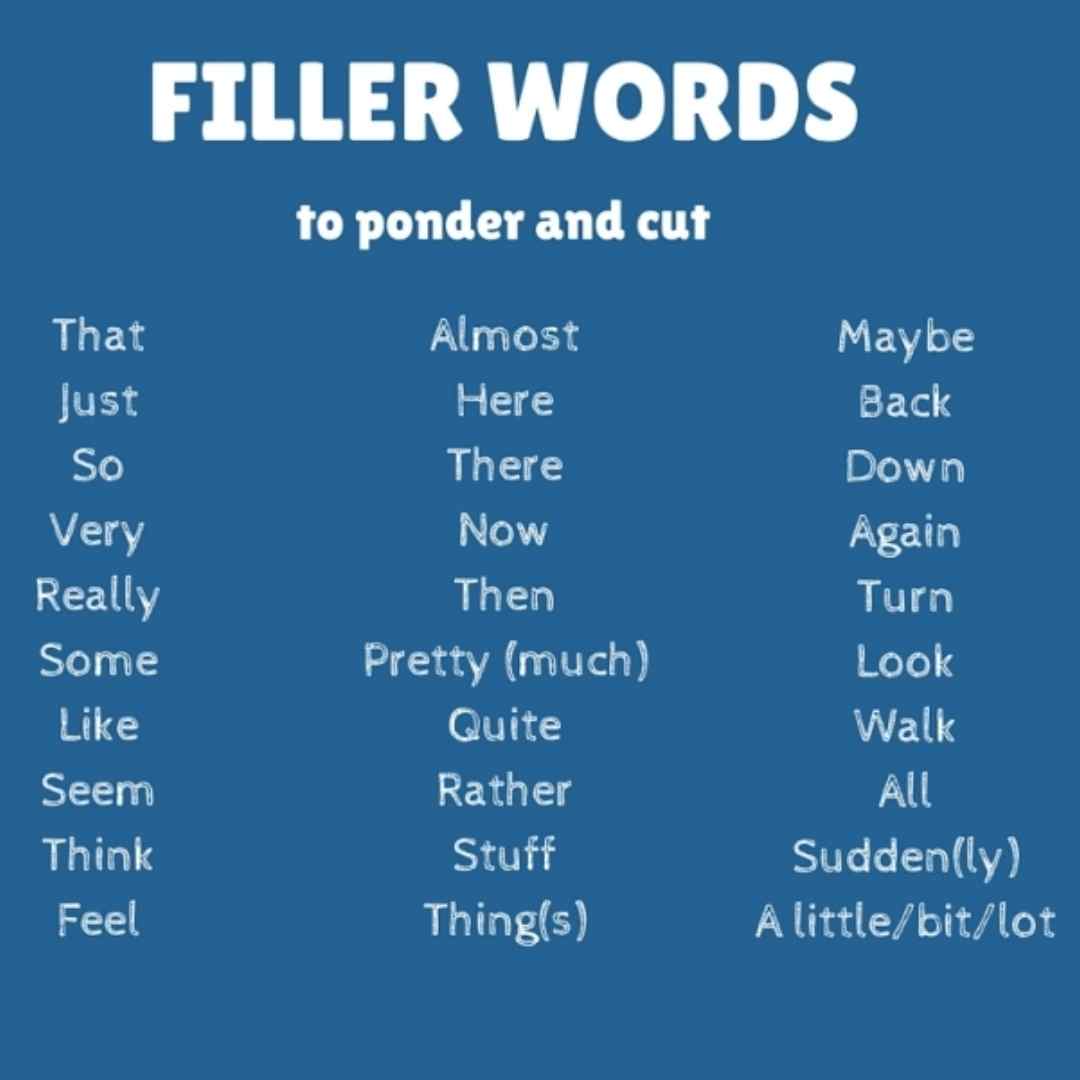
They not only create difficulties in following you when you speak but also give the impression that you lack confidence and authority.
To do this particular activity for public speaking:
- Record yourself speaking for thirty seconds on any subject.
- Make sure you leave out the filler words.
- When an ‘um’ comes up, restart and give it another go—ten times through, without any fillers.
4. Extempore
To do this activity for public speaking, capture yourself speaking spontaneously about any subject you find interesting. The only restriction is that you cannot arrange the topic and the speech beforehand . You can use your device’s stopwatch to start a one-minute countdown .

This exercise is meant to help you feel relaxed when speaking spontaneously. It will also help lessen the stress associated with worrying that you will run out of words to convey your idea. Try carrying out this public speaking activity in front of the class. Familiar faces always help!
5. Storytelling Using Pictures
Storytelling is essential to keep your listeners interested and assist them in remembering the particulars you’re delivering.

Please talk about the characters’ backgrounds, personalities, goals, driving forces, and everything else that will help write a fascinating tale about them.
6. Construct a Meaning
Whatever the subject of your speech, you must always come across as an expert on the subject.
To carry out this activity, select a term you are unfamiliar with . Then record yourself trying to give meaning to that unfamiliar word. Pay attention to how you can use your tone of voice to project a stronger sense of authority and influence.
Find Out More About Public Speaking as a Skill
Read Is Public Speaking a Skill to find out.
7. Questions for a Professional
To do this activity for public speaking, you’ll require a friend .
Pick a profession or subject that you are unfamiliar with. Invite a pal to ask you about it, and when they do, respond to their inquiries as if you were an experienced authority. This is a great exercise that will improve your confidence and presentation .
8. Prattle on about a Subject You Dislike
Excitement spreads easily. You must be EnthuZiastic about your issue for your listeners to be as well.
Pick anything you don’t care about, like a household tool, and practice talking excitedly about it. Use your tone, intensity, and gestures to convey the impression that it is the most exciting item in the world.
9. Write an advertisement
Since speeches are all about promoting a topic, develop the craft of marketing. In this way, you will be able to convince anyone and everyone.

Film yourself describing the object’s unique qualities, how it may help society, and why each person requires it in their possession.
10. The Origin Story
One activity for public speaking that will improve your storytelling abilities on stage.
Choose a household object, such as a stapler, and share a story of its name’s origins. Create your own story if you like. The goal here is to create the practice of locating and creating compelling narratives out of anything, not to be historically correct.
11. A Different Conclusion
OTT platforms have brought countless sitcoms and movies to our fingertips. We are glued to a show if it has a good plot and a cliffhanger. But, the ending of a show is what we take home. Now imagine your favorite show having two parallel finishes!

To do this activity for public speaking, you must start by choosing a popular television program or film. And you give it a different finish . Let your creativity run its entire course!
12. One Lie and Two Truths
This one is often relatively simple to beat and has tremendous excitement. And you’ll discover that while some people are good at it, it’s highly entertaining to see others stumble whenever they attempt to lie.

Call up all your close friends to partake this activity for public speaking. Now, o ne of your friends will stand up and say three facts about themselves . The catch here is that only two of them can be genuine . The third must be a fake .
The group must then decide which of the three was false before determining whether they were right. This one is, therefore, relatively short and incredibly simple, and you are not required to go into considerable length about it, but it is delightful.
You will win this game if you keep an eye on your friends’ behavioral cues. According to scientists , nonverbal communication helps us to understand a person’s personality. Also, it is an important aspect that will help you in your professional, as well as, your personal life.
Take note of things like eye contact, expressions, posture, hand movements, and voice tone since there are many different ways that people convey information.
13. A False Vacation
This activity for public speaking is mostly made up of one photo or a collection of similar photographs. It can be a farmhouse where you see pictures of animals, the barn, or anything amusing.

You must provide one, two, or three phrases for every picture before moving to the following one. The following image must then be used to carry on the narrative. As a result, you have to keep on making up stories to carry on the narrative.
How can public speaking skill be improved?
The best way to develop the skills for public speaking is to start small and keep practicing. Study the great public speakers, especially their mannerisms and tone.
How do you teach public speaking skills?
As a teacher, you need to understand your students. Please help them be the best version of themselves by providing feedback after every session. Do not forget to be patient with them.
What makes an excellent public speaker?
Speaking confidently in front of an audience is seen as more specific, correct, informed, clever, and likable than speaking less assuredly. Feeling anxious is normal, but if you want to succeed in public speaking, you must overcome your anxiety.
How to gain confidence in public speaking?
Maintaining eye contact with your listeners, using hand gestures to highlight points, and moving around the stage will help you appear confident on stage.
Being an excellent public speaker involves delivering engaging stories. You will become a more effective public speaker if you train yourself on how you can come up with innovative ideas for storytelling in the moment.
To educate yourself on being an excellent public speaker, you should frequently practice and make it enjoyable. It is similar to learning to ride a bike. In no time at all, you will develop the necessary skills.
If you had fun practicing these fun games and activities for public speaking, let us know in the comments.
Leave a comment Cancel reply
You must be logged in to post a comment.
15 Fun Public Speaking Activities for College Students
Hrideep barot.
- Public Speaking , Toastmasters

Public speaking activities for college students offer invaluable opportunities to develop essential communication skills, boost confidence, and prepare for future academic and professional endeavors. These activities go beyond the traditional classroom setting, providing engaging and interactive platforms for students to refine their public speaking prowess. Whether it’s through exercises that focus on vocal modulation and storytelling or games that encourage friendly competition, these activities empower college students to become more effective and articulate communicators. In this guide, we will explore a variety of public speaking activities and their benefits, offering college students a roadmap to becoming more confident and proficient speakers.
What is Public Speaking?
“Speak in such a way that others love to listen to you. Listen in such a way that others love to speak to you.” – Anonymous
Greetings, fellow wordsmiths and speech enthusiasts! If you’ve ever felt your heart race at the thought of addressing a crowd, or if you’ve found yourself tongue-tied when all eyes are on you, fear not! We’re diving headfirst into the exhilarating world of public speaking, where words wield power, charisma is your secret weapon, and confidence is your trusty sidekick.
In this captivating blog, we’ll unravel the art of public speaking, demystify stage fright, and equip you with the skills to command any room, from a cozy gathering of friends to a roaring auditorium filled with strangers. Get ready to discover the hidden orator within you and embark on a journey that promises not just personal growth but also oodles of fun.
So, whether you’re preparing to ace that next presentation, dazzle at a social event, or simply want to boost your communication prowess, join us on this electrifying adventure. As we explore the ins and outs of public speaking, we’ll throw in some tricks, share tales of triumphs and fumbles, and sprinkle in a dash of humor to make the journey as enlightening as possible.
Can Public Speaking be learned?
Contrary to popular belief, not all great speakers were born with a silver tongue. The majority of captivating orators you admire today started as mere mortals who stumbled over their words and faced their fair share of stage fright. Let’s dive into the fascinating world of public speaking and explore how this skill is cultivated.
The Natural Born Orator: Myth or Reality?
While some individuals possess an innate knack for public speaking from a young age, they are the exception, not the rule. These “natural born orators” are like unicorns in the speaking world, rare and enchanting. They effortlessly command attention, spin mesmerizing tales, and leave audiences hanging on their every word. But here’s the kicker: there are a few of them around!
The Majority: Made, Not Born
The truth is, most of the world’s renowned speakers, from Winston Churchill to Oprah Winfrey, Malcolm X to J.K. Rowling, didn’t emerge from the womb delivering flawless speeches. They developed their skills through dedication, practice, and a willingness to learn from their mistakes.
Consider this: according to studies, around 75% of people suffer from glossophobia , which is the fear of public speaking. This statistic alone should reassure you that you’re not alone in your struggles. Even some of the greatest public speakers initially grappled with stage fright and stumbled through their early speeches.
The Power of Learning and Practice
So, how do these once-timid souls transform into magnetic orators? They embrace the art of public speaking as a craft that can be cultivated by immersing themselves in the intricacies of effective communication, learning about body language, voice modulation, and the art of storytelling. They attend workshops, take public speaking courses, and practice their skills relentlessly.
Moreover, they aren’t afraid to learn from their missteps. Every “um” and “uh,” every moment of nervousness, is seen as an opportunity for improvement. They analyze their performances, seek feedback, and refine their technique. The bottom line is this: public speaking is a skill, not a genetic trait. With the right mindset, determination, and a bit of guidance, anyone can become a masterful speaker.
Best Public Speaking Activities for college students:
A) public speaking games for college students.
Public speaking games are interactive and engaging activities designed to improve public speaking skills, boost confidence, and enhance communication abilities. Games are interactive and often competitive, making learning more engaging and enjoyable. Here are some examples of public speaking games:
- 30 Second Speech
- Just A Minute Speech
- Debate Duels
- Storytelling Relay
- Public Speaking Bingo
- Speech Speed Dating
- Public Speaking Charades
- Speech Olympics
- Role Reversal
1. 30-second speech
What is the 30-second speech activity? Performing a 30-second speech in a classroom setting is a concise yet impactful way to communicate your ideas or present information. This activity typically involves standing in front of your classmates or audience and speaking for exactly 30 seconds on a chosen topic. The goal is to effectively convey your message within this short time frame while engaging your audience and leaving a lasting impression.
- Introduction (5-7 seconds): Begin with an engaging opener, stating your topic’s relevance.
- Main Message (15-18 seconds): Convey your core point concisely with supporting evidence.
- Conclusion (5-7 seconds): Summarize or issue a call to action to reinforce your message.
Rules and Tips:
- Manage time closely.
- Speak clearly and at a steady pace.
- Engage the audience with questions or prompts.
- Use confident body language.
- Utilize visual aids if allowed.
- Stay calm by practicing and taking deep breaths.
By adhering to these steps and guidelines, you can confidently deliver a compelling 30-second speech in class.
2. Just A Minute speech (JAM)
What is the Just A Minute speech activity? The “Just A Minute” ( JAM ) speech activity challenges participants to speak on a given topic for one minute without hesitation, repetition, or deviation. It fosters improvisational speaking skills and quick thinking.
Preparation:
- Topic Familiarization: Stay informed about various topics.
- Practice: Hone spontaneous speaking abilities on diverse subjects.
How to Do It:
- Selection: Participants are chosen randomly or in order.
- Topic Assignment: A moderator provides a topic, and the speaker has one minute to discuss it.
- Rules: Avoid hesitation, repetition, or deviation from the topic.
- Scoring: Judges evaluate adherence to rules, fluency, and content quality.
- The JAM speech activity is an enjoyable and educational exercise for enhancing public speaking and improvisation skills.
3. Debate Duels:
Activity: Debate duels involve organizing structured debates between two students or teams who argue opposing sides of a chosen topic. Participants present arguments, offer rebuttals, and conclude their case. The goal is to foster well-researched arguments and promote respectful discourse.
- Topic Selection: Choose a relevant and debatable topic.
- Research: Participants should research their respective positions thoroughly.
- Format: Decide on debate format (e.g., timed speeches, cross-examination).
- Roles: Assign roles such as debaters, moderators, and timekeepers.
- Opening Statements: Each side presents its arguments.
- Rebuttals: Teams respond to opponents’ arguments.
- Cross-examination (if included): Teams question each other.
- Conclusions: Summarize key points and restate positions.
- Maintain respect and civility.
- Use evidence and logic to support arguments.
- Stick to time limits for speeches.
- Follow the predetermined format.
Debate duels provide a platform for students to develop research, critical thinking, and communication skills through structured, respectful debate.
4. Storytelling Relay:
Activity: In a storytelling relay, teams of 3-4 students collaborate to create a narrative. It starts with one student providing an opening sentence, and each subsequent student adds one sentence to continue the story. The aim is to build a cohesive narrative with seamless transitions.
- Team Formation: Divide students into teams of 3-4 members.
- Topic or Theme: Decide if there’s a specific topic or theme for the stories.
- Order: Determine the order in which students will contribute to the story.
- Time Limit: Set a time limit for each sentence contribution, e.g., 10 seconds.
- Opening Sentence: The first student in each team provides an opening sentence to begin the story.
- Sentence Contributions: Each student takes turns adding one sentence to continue the narrative.
- Transitions: Students must ensure their sentences connect smoothly with the previous ones.
- Cohesion: Teams collaborate to maintain consistency and coherence in the story.
- Maintain the predetermined order for sentence contributions.
- Keep sentences concise and on-topic.
- Ensure sentences flow logically from one another.
- Encourage creativity and adaptability.
Storytelling relay is a creative and collaborative activity that fosters teamwork, creativity, and improvisation skills as students work together to build a compelling story.
5. Public Speaking Bingo:
Activity: In Public Speaking Bingo, bingo cards with different public speaking challenges in each square are created (e.g., “Use a compelling statistic,” “Maintain eye contact,” “No filler words”). During speeches, students mark off squares as they complete the challenges, aiming to achieve a bingo.
- Bingo Cards: Create bingo cards with various public speaking challenges randomly placed in each square.
- Topics: Prepare speech topics or allow students to choose their own.
- Markers or Chips: Provide markers or chips for students to use when they complete a challenge.
- Prizes (optional): Consider offering small prizes for students who achieve bingo.
- Card Distribution: Distribute the bingo cards to students before the speeches begin.
- Speeches: As students give their speeches, they mark off squares when they complete the challenges listed.
- Winning: The first student to complete a row, column, or diagonal with marked squares shouts “Bingo!” and wins the game.
- Challenges must be completed during the speech.
- Challenges should be marked off honestly.
- The winner should declare “Bingo” immediately upon completing a line of challenges.
Public Speaking Bingo is a fun and interactive activity that encourages students to focus on specific public speaking skills and techniques while delivering speeches, making the learning experience engaging and enjoyable.
6. Speech Speed Dating:
Activity: Speech Speed Dating involves pairing students and giving them 3-5 minutes each to introduce themselves or present a mini-topic. After each “date,” students switch partners. This exercise helps improve speaking under time constraints and fosters active listening skills.
- Pairing: Arrange students in pairs.
- Topics (optional): Prepare mini-topics or allow students to choose what they’ll speak about.
- Timer: Set a timer for each speaking session.
- Space: Ensure there’s enough space for students to move between partners.
- Introduction: Students introduce themselves or present their mini-topic to their partner within the time limit.
- Switch Partners: After the allotted time, students rotate to a new partner and repeat the process.
- Repeat: Continue this cycle for multiple rounds, allowing students to interact with different partners.
- Stick to the time limit for each speaking session.
- Encourage active listening and engagement during each “date.”
- Ensure students switch partners as instructed to maximize interaction.
Speech Speed Dating is a dynamic activity that enhances students’ ability to convey information succinctly and promotes effective listening and engagement in a fast-paced speaking environment.
7. Public Speaking Charades:
Activity: Public Speaking Charades involves creating cards with different public speaking scenarios or gestures (e.g., “Giving a TED Talk,” “Delivering bad news”). Students act out these scenarios without speaking, and the audience guesses what they’re portraying. This exercise enhances nonverbal communication skills.
- Scenario Cards: Prepare cards with various public speaking scenarios or gestures.
- Audience: Arrange for an audience or divide students into small groups to take turns acting and guessing.
- Timer: Set a timer for each acting session.
- Card Draw: One student draws a scenario card and acts it out without speaking.
- Guessing: The audience or other students guess what public speaking scenario is being portrayed.
- Rotation: After a set time or when the correct guess is made, a new student takes a turn.
- No speaking or verbal cues are allowed during the charades.
- Encourage creative and expressive gestures to convey the scenario.
- Keep the game moving by setting time limits for each turn.
Public Speaking Charades is a lively activity that sharpens nonverbal communication skills and creativity while making public speaking scenarios more engaging and memorable.
8. Speech Olympics:
Activity: Speech Olympics is a structured competition where students participate in a series of public speaking challenges, which can include tongue twisters, impromptu storytelling, persuasive pitches, and more. Participants earn medals or points based on their performance. This activity provides a fun and lighthearted way to develop various speaking skills.
- Challenge Selection: Choose a variety of speaking challenges that suit the skill levels of the participants.
- Scoring System: Determine how participants will earn points or medals (e.g., judging panels or audience voting).
- Materials: Prepare any necessary materials or props for specific challenges.
- Medals or Prizes: Optional – acquire medals or prizes for winners.
- Introduction: Explain the rules and challenges to the participants.
- Challenge Rotation: Participants move through a series of challenges, competing against each other.
- Scoring: Use the predetermined scoring system to assess performance and award medals or points.
- Winners: Announce the winners and celebrate their achievements.
- Participants must adhere to the specific rules of each challenge.
- Judges or the audience score performances based on predefined criteria.
- Encourage sportsmanship and respectful competition.
Speech Olympics is a dynamic activity that allows students to practice a range of speaking skills competitively and engagingly, making it an enjoyable learning experience.
9. Role Reversal:
Activity: In Role Reversal, students play both the role of the speaker and the audience. After delivering a speech, they switch roles, with the audience members providing constructive feedback to the speaker. This exercise helps students gain insight into the audience’s perspective and fosters effective feedback skills.
- Speech Topics: Assign or allow students to choose their speech topics.
- Feedback Guidelines: Prepare guidelines for constructive feedback.
- Peer Evaluation Forms: Create forms or worksheets for audience members to provide feedback.
- Speaker’s Turn: A student delivers a speech on their chosen topic.
- Role Reversal: After the speech, the roles switch, and the audience becomes the feedback provider.
- Feedback Session: The audience offers constructive feedback, focusing on strengths and areas for improvement.
- Discussion: Encourage a brief discussion where the speaker can ask clarifying questions or provide context for their choices.
- Feedback should be respectful and constructive, focusing on the speech’s content and delivery.
- Encourage active listening and thoughtful feedback from the audience.
- The speaker should be receptive to feedback and open to improvement suggestions.
Role Reversal is an interactive exercise that enhances students’ understanding of both the speaker and audience perspectives, promoting effective communication skills and constructive feedback within a learning environment.
B) Public Speaking Exercises for college students:
Public speaking exercises are structured activities and practices aimed at improving public speaking skills. Exercises are structured activities that often focus on specific aspects of public speaking, such as breath control, diction, or body language. Each exercise typically targets a specific aspect of public speaking or communication. Here are some common public speaking exercises:
- Breathing Exercises
- Tongue Twisters
- Mirror Practice
- Storytelling Practice
- Impromptu Practice
- Emotional Vocal Modulation
1. Breathing Exercises
Diaphragmatic breathing is a technique that involves using your diaphragm, a muscle located below your ribcage, to control your breath. It is a fundamental exercise for improving vocal projection and managing anxiety during speaking or public speaking situations.
How to Do It: To perform diaphragmatic breathing, sit or stand comfortably with proper posture. Inhale deeply through your nose for a slow count of four, allowing your diaphragm to expand and your lower lungs to fill. Hold your breath for four counts without tensing your chest or neck. Then, exhale slowly and steadily through your mouth for another count of four. Repeat this breathing pattern regularly to strengthen your diaphragm, enhance vocal projection, and reduce anxiety associated with speaking engagements.
2. Tongue Twisters:
Tongue twisters are word or phrase sequences designed to be challenging to articulate due to their repetitive or tricky sounds. This exercise is used to improve pronunciation, diction, and speech clarity.
How to Do It: To perform tongue twisters, start with simple ones and gradually advance to more complex ones as your proficiency grows. Pronounce each word or phrase, emphasizing correct articulation, and gradually increase your speed. The goal is to challenge your tongue and mouth muscles, enhancing your ability to enunciate words clearly and improving your overall speech clarity.
- She sells seashells by the seashore.
- Fuzzy Wuzzy was a bear; Fuzzy Wuzzy had no hair. Fuzzy Wuzzy wasn’t very fuzzy, was he?
- How can a clam cram in a clean cream can?
- Unique New York, you know you need a unique New York.
- Red leather, yellow leather.
- Six slippery snails slid slowly seaward.
- Betty Botter bought some butter but the butter was bitter, so Betty bought some better butter to make the bitter butter better.
- Peter Piper picked a peck of pickled peppers. How many pickled peppers did Peter Piper pick?
- Irish wristwatch, Swiss wristwatch.
3. Mirror Practice:
Mirror practice is a technique used to enhance your public speaking skills. It involves standing in front of a full-length mirror while delivering a speech or presentation. The aim is to closely observe and improve your body language, facial expressions, and gestures as you speak.
How to Do It: To perform mirror practice, position yourself in front of a full-length mirror, ensuring you have a clear view of yourself. Deliver your speech or presentation as you normally would, paying keen attention to your reflection. Focus on your posture, hand movements, facial expressions, and any other nonverbal cues you use while speaking. By actively observing yourself in the mirror, you can identify areas for improvement in your delivery and work on refining your public speaking skills over time.
4. Storytelling Practice:
Storytelling practice involves sharing personal anecdotes or stories with friends or peers while incorporating storytelling techniques such as creating suspense, infusing humor, and using vivid descriptions. This practice is aimed at refining your storytelling skills and making your narratives more engaging.
How to Do It: To perform storytelling practice, select a personal anecdote or story you’d like to share. As you share it with friends or peers, focus on the storytelling elements. Create suspense by building anticipation and keeping your audience curious about what happens next. Infuse humor by adding funny anecdotes or witty remarks where appropriate. Use vivid descriptions to paint a clear picture and evoke emotions. By practicing storytelling in this way, you can develop your ability to captivate your audience and make your narratives more compelling.
5. Impromptu Topics:
Impromptu topics practice involves regularly engaging in impromptu speaking by selecting random topics or prompts and delivering short, on-the-spot speeches about them. This exercise is designed to sharpen your ability to think quickly and articulate ideas effectively without prior preparation.
How to Do It: To perform impromptu topic practice, have a selection of random topics or prompts ready. These topics can be related to various subjects, such as current events, personal experiences, or hypothetical scenarios. Choose a topic at random and challenge yourself to deliver a brief speech or response to it without any prior planning or research. This exercise will help you become more comfortable with spontaneous speaking, improve your ability to organize your thoughts quickly and enhance your overall communication skills.
6. Emotional Vocal Modulation:
Emotional vocal modulation is a technique used to enhance the expressiveness of your speeches. It involves practicing the variation of your tone, pitch, and inflection to convey different emotions effectively. By modulating your voice, you can captivate your audience and convey a range of feelings and sentiments in your presentations.
How to Do It: To perform emotional vocal modulation, start by selecting a piece of text or speech. As you practice, deliberately vary your tone, pitch, and inflection to match the emotions or sentiments you want to convey. Experiment with different vocal techniques, such as using a higher pitch for excitement, a lower pitch for seriousness, or fluctuating tone for emphasis and engagement. Regular practice of emotional vocal modulation will help you become a more dynamic and compelling speaker, capable of engaging your audience on an emotional level.
Where to start Public Speaking?
Starting on the path of public speaking as a college student is a wise decision that can have a significant impact on your academic and professional life. Here’s a step-by-step guide to help you get started:
1. College Public Speaking Courses:
College public speaking courses are an excellent starting point for students eager to develop their speaking skills. These courses typically provide a structured and comprehensive approach to public speaking. You’ll learn about speech organization, effective delivery techniques, and strategies to engage your audience. Instructors are often experienced public speakers who can offer valuable insights and feedback.
Additionally, these courses offer a supportive environment for practicing your speaking skills. You’ll have the opportunity to present speeches in front of your peers, receive constructive criticism, and refine your abilities. As a bonus, college courses often provide resources like textbooks and access to speech labs to help you master the art of public speaking.
“The best way to conquer stage fright is to know what you’re talking about.” — Michael H. Mescon
2. Join Public Speaking Clubs:
Toastmasters and similar public speaking clubs are renowned for their ability to transform nervous speakers into confident orators. These clubs provide a supportive community of individuals who share a common goal: improving their public speaking skills. They offer a structured framework where you can gradually work your way up from short impromptu speeches to longer prepared presentations.
What makes these clubs invaluable is the frequent practice opportunities they provide. You can refine your skills in a nonjudgmental environment, receive feedback, and witness the progress of fellow members. Joining such a club can be a powerful stepping stone in your public speaking journey.
Toastmasters International has over 364,000 members in 16,200 clubs in 145 countries.
You can join our online community of Toastmasters for engaging in Learning and Group Discussions here.
3. Online Public Speaking Resources:
In today’s digital age, a wealth of online resources is readily available to aid in your public speaking education. You can find books, articles, videos, and courses dedicated to the subject. These resources cover a wide range of topics, from speech preparation and delivery techniques to managing stage fright.
The advantage of online resources is their accessibility and flexibility. You can explore these materials at your own pace, focusing on areas that need improvement. Whether you’re looking for expert advice, speech templates, or video tutorials, the internet offers a vast repository of knowledge to help you become a more effective speaker.
Over 3,000 books on public speaking are available on Amazon.
4. Self-Practice and Recording:
Self-practice is a fundamental component of improving your public speaking skills. Whether it’s practicing in front of a mirror, recording your speeches, or rehearsing in an empty room, these exercises help you become more comfortable with your own voice and body language.
Recording yourself is particularly valuable as it allows you to objectively assess your performance. You can analyze aspects like tone, gestures, and clarity of speech. By identifying areas that need refinement, you can tailor your practice sessions to address specific weaknesses and gradually build confidence.
“Practice puts brains in your muscles.” — Sam Snead
5. Seek Feedback from Professors and Peers:
Constructive feedback is an essential component of growth as a speaker. Don’t hesitate to reach out to professors and peers for input on your presentations. Professors, with their expertise, can offer valuable insights into your content, organization, and delivery.
Additionally, peers can provide a different perspective and offer suggestions for improvement. Collaborative learning and sharing feedback within your academic community can enhance your speaking skills and help you gain a fresh outlook on your strengths and weaknesses as a speaker.
In a survey, 94% of employees said they’d benefit from feedback, according to Harvard Business Review.
6. Volunteer for Speaking Opportunities:
Volunteering to speak in class or participate in campus events is a practical way to apply what you’ve learned. These opportunities allow you to gain real-life experience, helping you overcome nerves and improve your ability to connect with an audience.
Whether it’s delivering a presentation in front of your classmates or addressing a larger crowd at a campus event, each experience contributes to your growth as a speaker. The more you put yourself in these situations, the more confident and adept you’ll become at conveying your message effectively.
Example: Delivering a class presentation on a topic you’re passionate about.
7. Study Renowned Speakers:
Studying the speeches of renowned public speakers is a powerful way to improve your skills. Analyzing speeches from figures like Martin Luther King Jr., Winston Churchill, Oprah Winfrey, or TED Talk presenters can provide valuable insights into effective rhetoric, storytelling, and engagement techniques.
By dissecting these speeches, you can learn how to structure your content, use persuasive language, and capture your audience’s attention. It’s a practical way to see proven strategies in action and apply them to your presentations.
Example: Analyzing Martin Luther King Jr.’s “I Have a Dream” speech for rhetorical techniques.
These seven options offer a diverse range of opportunities for college students to embark on their journey toward becoming effective public speakers. Whether you choose formal education, community support, online resources, or practical experience, remember that the key to success is consistent practice and a commitment to personal growth. Developing your public speaking skills will not only benefit your academic pursuits but also prepare you for future personal and professional endeavors.
Conclusion:
The world of public speaking holds endless possibilities for college students. It’s a realm where your voice, ideas, and stories can resonate and inspire. While the journey to becoming a confident and skilled speaker may seem daunting, the key is to remember that every great orator, from the classroom to the TED stage, started somewhere.
The most crucial step is to just start. Put yourself out there, embrace the challenges, and dive into public speaking activities and exercises. As you navigate tongue twisters, engage in debate duels, or share personal anecdotes, you’re not only honing your communication skills but also building the confidence needed to succeed in academia and the professional world.
Don’t let fear or self-doubt hold you back. The first step may be the most challenging, but it’s also the most transformative. So, seize every opportunity, participate in these activities with enthusiasm, and let your voice be heard. With each word you speak and every audience you engage, you’re inching closer to becoming the confident, influential speaker you aspire to be. Start now, and watch as your public speaking journey unfolds, revealing the remarkable communicator within you.
To seek professional guidance and mentorship for public speaking or Toastmasters, you can reach out to us over here .
Enroll in our transformative 1:1 Coaching Program
Schedule a call with our expert communication coach to know if this program would be the right fit for you

Lost Voice? Here’s How to Recover Sore Throat and Speak Again

7 Keys to Emcee Like a Pro: Unlock Your Hosting Potential

8 Ways to Rise Above the Noise to Communicate Better

- [email protected]
- +91 98203 57888
Get our latest tips and tricks in your inbox always
Copyright © 2023 Frantically Speaking All rights reserved
Kindly drop your contact details so that we can arrange call back
Select Country Afghanistan Albania Algeria AmericanSamoa Andorra Angola Anguilla Antigua and Barbuda Argentina Armenia Aruba Australia Austria Azerbaijan Bahamas Bahrain Bangladesh Barbados Belarus Belgium Belize Benin Bermuda Bhutan Bosnia and Herzegovina Botswana Brazil British Indian Ocean Territory Bulgaria Burkina Faso Burundi Cambodia Cameroon Canada Cape Verde Cayman Islands Central African Republic Chad Chile China Christmas Island Colombia Comoros Congo Cook Islands Costa Rica Croatia Cuba Cyprus Czech Republic Denmark Djibouti Dominica Dominican Republic Ecuador Egypt El Salvador Equatorial Guinea Eritrea Estonia Ethiopia Faroe Islands Fiji Finland France French Guiana French Polynesia Gabon Gambia Georgia Germany Ghana Gibraltar Greece Greenland Grenada Guadeloupe Guam Guatemala Guinea Guinea-Bissau Guyana Haiti Honduras Hungary Iceland India Indonesia Iraq Ireland Israel Italy Jamaica Japan Jordan Kazakhstan Kenya Kiribati Kuwait Kyrgyzstan Latvia Lebanon Lesotho Liberia Liechtenstein Lithuania Luxembourg Madagascar Malawi Malaysia Maldives Mali Malta Marshall Islands Martinique Mauritania Mauritius Mayotte Mexico Monaco Mongolia Montenegro Montserrat Morocco Myanmar Namibia Nauru Nepal Netherlands Netherlands Antilles New Caledonia New Zealand Nicaragua Niger Nigeria Niue Norfolk Island Northern Mariana Islands Norway Oman Pakistan Palau Panama Papua New Guinea Paraguay Peru Philippines Poland Portugal Puerto Rico Qatar Romania Rwanda Samoa San Marino Saudi Arabia Senegal Serbia Seychelles Sierra Leone Singapore Slovakia Slovenia Solomon Islands South Africa South Georgia and the South Sandwich Islands Spain Sri Lanka Sudan Suriname Swaziland Sweden Switzerland Tajikistan Thailand Togo Tokelau Tonga Trinidad and Tobago Tunisia Turkey Turkmenistan Turks and Caicos Islands Tuvalu Uganda Ukraine United Arab Emirates United Kingdom United States Uruguay Uzbekistan Vanuatu Wallis and Futuna Yemen Zambia Zimbabwe land Islands Antarctica Bolivia, Plurinational State of Brunei Darussalam Cocos (Keeling) Islands Congo, The Democratic Republic of the Cote d'Ivoire Falkland Islands (Malvinas) Guernsey Holy See (Vatican City State) Hong Kong Iran, Islamic Republic of Isle of Man Jersey Korea, Democratic People's Republic of Korea, Republic of Lao People's Democratic Republic Libyan Arab Jamahiriya Macao Macedonia, The Former Yugoslav Republic of Micronesia, Federated States of Moldova, Republic of Mozambique Palestinian Territory, Occupied Pitcairn Réunion Russia Saint Barthélemy Saint Helena, Ascension and Tristan Da Cunha Saint Kitts and Nevis Saint Lucia Saint Martin Saint Pierre and Miquelon Saint Vincent and the Grenadines Sao Tome and Principe Somalia Svalbard and Jan Mayen Syrian Arab Republic Taiwan, Province of China Tanzania, United Republic of Timor-Leste Venezuela, Bolivarian Republic of Viet Nam Virgin Islands, British Virgin Islands, U.S.

- Presentation Hacks

10 Public Speaking Games and Activities to Try
- By: Kelly Allison
Public speaking is a skill like any other—to become great at it, you need to practice. But if you’re like most, then you probably don’t have a room full of people at the ready that you can speak in front of every day. Don’t let that stop you from practicing, though.
There are actually a ton of games and activities you can take advantage of that’ll help you hone your chops and become the best presenter you can be without the need for a formal audience.

Speak Nonsense According to research , an excellent presentation is 38% your voice, 55% non-verbal communication and just 7% your content. In other words, your delivery matters even more than what you say, and this exercise helps you refine it. Find a paragraph online in a language you don’t understand or simply write down a few lines of jibberish, and practice saying it aloud as though you’re giving a speech. Pay mind to your tone, inflections, and generally how you can use your voice to create more interest.
Learn From the Pros Look online for speeches that are widely accepted as exceptional. The most popular TED Talks of all time is a great place to start. Pick a talk that you’re interested in and watch it through a critical lens. Analyze the narrative structure the speaker uses, what makes their delivery effective, how their visuals enhance their talk and other components that make their speech extraordinary.
30 Seconds Filler-Free Filler words like “uh” “um” and “y’know” not only make your talk more difficult to listen to, but they also make you seem less prepared and authoritative. For this exercise, record yourself giving a talk on any topic for 30 seconds, taking care to omit all filler words. Whenever you use a filler word, start over and try again. Do this exercise ten times, filler-free.
One Minute Off-the-Cuff For this exercise, you’ll set a timer on your phone for one minute and record yourself giving an impromptu speech on any topic that interests you. The only rule is that you can’t prepare for it in any way. This is designed to get you more comfortable speaking off-the-cuff and minimize the anxiety that comes from being afraid you won’t have anything to say.
Tell a Photo Story Storytelling is critical to engaging your audience and helping them retain the information you’re sharing. To practice developing narratives, find an interesting photo online and record yourself presenting a story about it. Discuss what you think the backstory is, who the people are, their dreams, their motivations, and anything else that’ll tell a compelling story about them.
Make Up a Definition No matter what your presentation is about, you should always seem like you have authority over the topic. For this exercise, choose a word you don’t know the definition of and record yourself saying, with authority, what you think it means. Pay attention to how you can use your voice and intonations to have more command and seem more authoritative.
Q&A With an Expert You’ll need to find a friend for this one. Choose a topic or job that you don’t know much about. Ask your friend to interview you about it and answer their questions as though you’re a well-informed expert. This will help you with both your delivery and authority.
Gush About Something You Don’t Love Enthusiasm is contagious. If you want your audience to be excited about your topic, then you need to show enthusiasm for it. Choose something you’re indifferent about, say, a kitchen utensil, and practice speaking about it enthusiastically. Use your voice, emphasis, and body language to make it seem like the most exciting thing in the universe.
Make a Commercial Presentations are all about selling an idea, so you should practice the art of sales and persuasion to be the best you can be. Choose an item in your home and create a one-minute commercial about it. Record yourself saying what makes it special, how it can enhance lives, and why everyone needs that item in their corner.
Where Did That Name Come From? This is another exercise that’ll make you a better storyteller on stage. Pick an item in your home, like a stapler, and tell a story about how it got its name. The idea here isn’t to be accurate, so by all means, make something up; this is just to get you in the habit of finding and developing interesting stories from anything.
Looking for more ways to improve your presentation game? Then take Ethos3’s Badge Assessment to discover your unique presentation persona.
Kelly Allison
Join our newsletter today.
© 2006-2024 Ethos3 – An Award Winning Presentation Design and Training Company ALL RIGHTS RESERVED
- Terms & Conditions
- Privacy Policy
- Diversity and Inclusion

Public Speaking Activities for Secondary Students
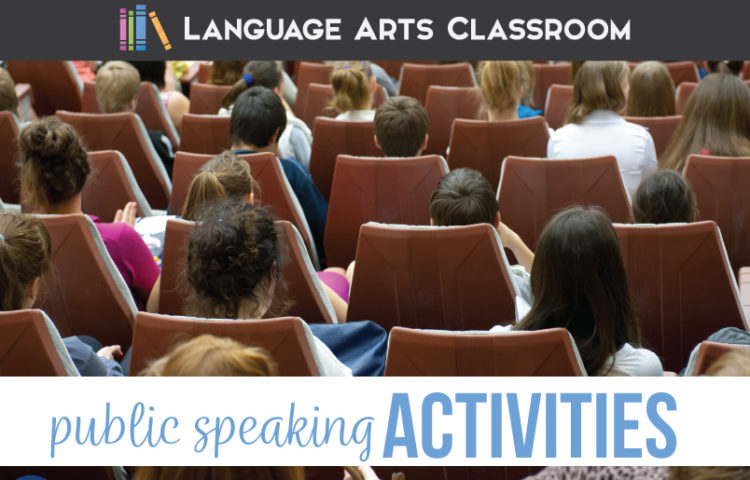
Read on for six public speaking activities. Then, sign up for a free download of the activities that you can hopefully use in diverse ways, even as public speaking games.
I earned an endorsement in “speech” for my teaching license. (I’m in Illinois.) In college, I took extra communication courses and observed high school speech classes. Plenty of my extracurricular activities (plus my classes) required me to prepare and deliver speeches. When I started teaching, I had experienced public speaking activities as a student and a teacher observer.
Still, I felt underprepared to teach public speaking. I had zero speech activities for high school students. My first year of teaching, I thought materials were lacking on the Internet, from textbooks, from anywhere (and I searched). This was pre-TpT and I was sinking or swimming. My textbook for the class was about sixty years old, and I had no teacher edition.
That first year I did lots of paddling, but over the years I grew confident in teaching a speech class. I developed fun impromptu speech activities and other speech activities for high school students.
That isn’t to say that I didn’t make mistakes ; I made plenty. Through messy lessons, too-short of lessons, and confused students, I learned to provide structure for students without squashing them. I realized how much preparation was needed. I changed basic rubrics to rubrics that encouraged students to set goals and take ownership of their improvement. Scaffolding and modeling became part of my class.
So! I improved and reflected. After years of teaching public speaking, I crafted ideas for what would help young speakers. Hopefully, these activities help your speech classes too.
What are some ice-breaker exercises that can be used in a public speaking activity?
Some ice-breaker exercises that can be used in public speaking activities include “Two Truths and a Lie,” where participants share two true statements and one false statement about themselves, and “Would You Rather,” where participants are asked to choose between two options and explain their choice.
What about public speaking games?
Sometimes, structure helps young speakers, so I created these public speaking activities to address common areas of concern with high schoolers. Most students fear the nature of a speech class, use too many fillers when speaking, and focus on one area, such as volume and forget about the rest: non-verbal communication, tone, eye contact, etc.
Through coaching speech, spending many weekends at speech tournaments, and teaching public speaking, I created these public speaking activities. I’ve seen variations of these or adapted these from activities geared toward younger students. These speech activities should work well with high school students, but you can modify them for middle school or college speech classes.
These are included in my public speaking unit as well because they can be used numerous times.

Fillers can distract an audience from hearing a really well-developed speech. First, not all fillers are bad. We naturally pause and add fillers. The abundance of fillers, however, can be distracting.
Sometimes speech students are unaware that they use fillers. Other times, students become nervous, pause, and fill the empty time with a filler. Talk with students about the reasons why fillers occur and if they have a time they rely on one. Showing compassion and understanding about a common problem during speeches will relax students, and they will be more likely to work on eliminating an abundance of fillers.
After showing compassion, play public speaking games to address filler words.
Before starting, choose your topic and write a list of common fillers that don’t positively add to spoken communication: um, yeah, like, uh. Ask students to contribute to the list. I normally write the list so that students can consult it.
Instruct students to speak for 30 seconds (vary the time if necessary) and not use any fillers. Students should realize how easily fillers creep into their speech. NOW! Everyone uses some fillers, and fillers can make public speaking natural. However, too many fillers can distract audiences.
Each student will give a short speech for 30 seconds. The topic isn’t too important. You can choose one for the entire class or allow students to choose.
Students must restart their speech if they use a filler. Some students will try to pause and draw out the speech by not speaking, but most students speak at a normal pace. Overall, the audience is compassionate toward the speaker because everyone realizes the difficulty of not relying on these words.
This activity is perfect after the first formal speech. Students need to decompress, but they also need to eliminate fillers. When I ask students to write goals for their future speeches, eliminating fillers is a common goal.
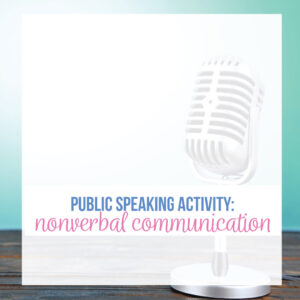
2. Nonverbal practice
Nonverbal communication matters. To help students experience that, ask them to perform an activity where the focus is nonverbal communication.
Students will line up in alphabetical order only using nonverbal communication. I have students line up by order of their middle names since they typically know everyone’s last names. They experiment with different forms of nonverbal communication and have fun. Most often they make a capital letter with their fingers. If some students know middle names, they will switch classmates around.
The real practice is when students realize many of them have a middle name that starts with the same letter. “A” is a common one. Then students must figure out how to communicate the second letters of Aarron, Ann, Alice, and Abraham. I will say I’ve never had a class line up correctly.
This activity is the perfect introduction to nonverbal communication. As students continue through the semester, they’ll be able to focus on purposeful movements that emphasize their points. This nonverbal activity breaks the ice as you start to work on nonverbal communication. I never plan on this nonverbal practice becoming a public speaking game, but it often does.
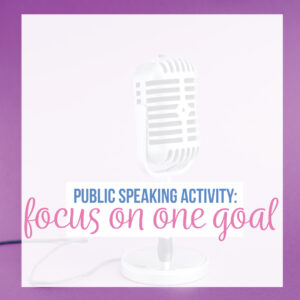
3. One goal
Speeches can overwhelm students. Help students focus on one goal. The best part about the “one goal” activity is that students choose their focus which creates less work for you and buy-in for students.
As students continue with class, ask them what area they see as the greatest potential for improvement. Brainstorm areas as a class. There is no right or wrong! Students normally list eye contact, proper volume level, appropriate nonverbal communication, and natural movement. Then let students decide what they desire to improve.
Students will individually decide what they want to improve in their speaking—they will each have a goal. Some students want to work on eye contact, others want to balance their volume, others want to stop fidgeting. Then I divide students into small groups. Students will practice the current speech they are creating, receiving constructive feedback when they need to correct an action to meet their goal. Their group will also tell them when they did well and moved toward meeting their goal.
(This is a bit like #1 but fillers are such a huge issue with high school orators that it gets its own activity.) I normally do this activity later in the year after students are comfortable with each other. I also don’t do this activity if I feel a class may not give meaningful feedback. Finally, I share with students that improving in an area is part of most jobs. In teaching, for example, teachers often record themselves and reflect on the video later. They then develop goals for improvement in their profession. (Sometimes it is a public speaking goal!)
This activity works well to meet individual goals and to build classroom community. My speech rubrics contain a spot for consideration on improvement of a goal. Plus, the art of reflection will serve students in any field or career, so I stress that message to them. This focused practice works well because it encourages students to work on a goal in which the teacher had very little involvement.
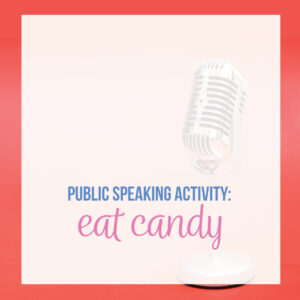
4. M&M/ Skittles
Who doesn’t like candy? With this fun exercise, students share information about a topic. You’ll get students talking in a low-stress, engaging way.
This candy activity is fun and quick. Bring a large bag of small candies like M&M or Skittles to class. Ask students to take as many pieces of candy as they like, but stress not to eat the candies yet. Pass the bag around. Then, students must tell a fact about themselves for each piece of candy. 15 pieces of candy? 15 facts.
This also works with review. 5 pieces of candy? Review 5 facts with the class concerning public speaking terms. After speaking, students may eat their candy. I’ve used a similar process in other classes to review material.
This activity works well as a review or as a first day of school activity. Students are publicly speaking in their speech class on the first day of school without any feedback or real regulations. Since the process is fun, their first experience in class is a positive one. Plus, the candy aspect lends itself to making a public speaking game.
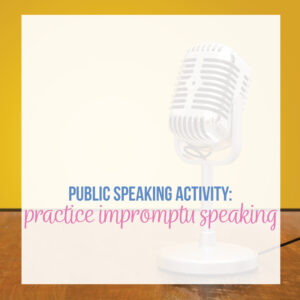
5. Impromptu
Most speeches in real life are actually impromptu speeches. Interviews, business meetings, and proposal presentations require people to think quickly and to speak eloquently, all while proving their point. Body language matters too!
Activate prior knowledge with a bit of an anticipatory set. Ask students about a time they gave an impromptu speech (even though they did not probably label it “impromptu” at the time!). Most people can relate to the frustration of having ideas but not conveying them well. Many times, people think of what they should have said days later! Students probably face this frustration. Acknowledge that feeling, share they you’ve experienced it too, and supply a solution.
Thinking and speaking on your feet might come naturally to some people. With practice, even those who struggle to articulate their ideas under pressure can improve.
Have students organize a speech quickly by delivering an impromptu speech. Often I would ask a class to write a topic on a piece of paper. (Sometimes I would say that the topic needed to be persuasive or informative—but it always needed to be clean.) Students would write their topic, add it to a box, and draw from a box. The topics were great because I didn’t make them and because students knew they had the potential to draw their own.
After drawing, provide 30 seconds to outline their speech. Then, students will talk about the topic for one minute. As the school year continued, I would increase the speaking time.
Older students who have been in class for a bit will probably organize their speech with a general introductory statement, two concepts, and a concluding statement. (That varies, of course.) If students struggle with the format, create a quick outline they can apply to their topics.
Students enjoy creating their own topics and learn to speak on the spot in a mature, organized manner. At first, students groan about impromptu speaking. This area is actually where I see the most growth. Students gain confidence that they can think and speak quickly, and they start to enjoy the process.
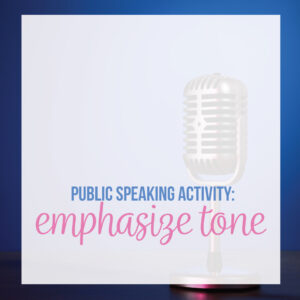
Tone matters! Many adults don’t realize the tone that they convey shapes their communication. We should certainly work with our students concerning tone so that they are aware of its power. Not only can the wrong tone hurt speakers, but the right tone can also emphasize their message.
Define “tone” for students. Brainstorm times that students know their tone has affected them. (Normally students share stories about times they were in trouble with their parents for having the wrong tone.) Then think of times that the right tone conveyed the correct message. Students might struggle to come up with examples for best use of tone. Oftentimes, a tone that matches a speaker’s message doesn’t stand out, and that is probably because the tone was woven into the message so well.
Experiment with tone with students. Put students into groups, and assign a speaker. (Everyone will have the chance to be a speaker.) Give the speaker a list of emotions and a list of generic statements. Then ask the speaker to choose a question and an emotion that conveys tone.
Finally, the rest of the group must decide the speaker’s tone. This opportunity allows for discussion about intentional tone and miscommunication. You’ll want to circulate as students practice this.
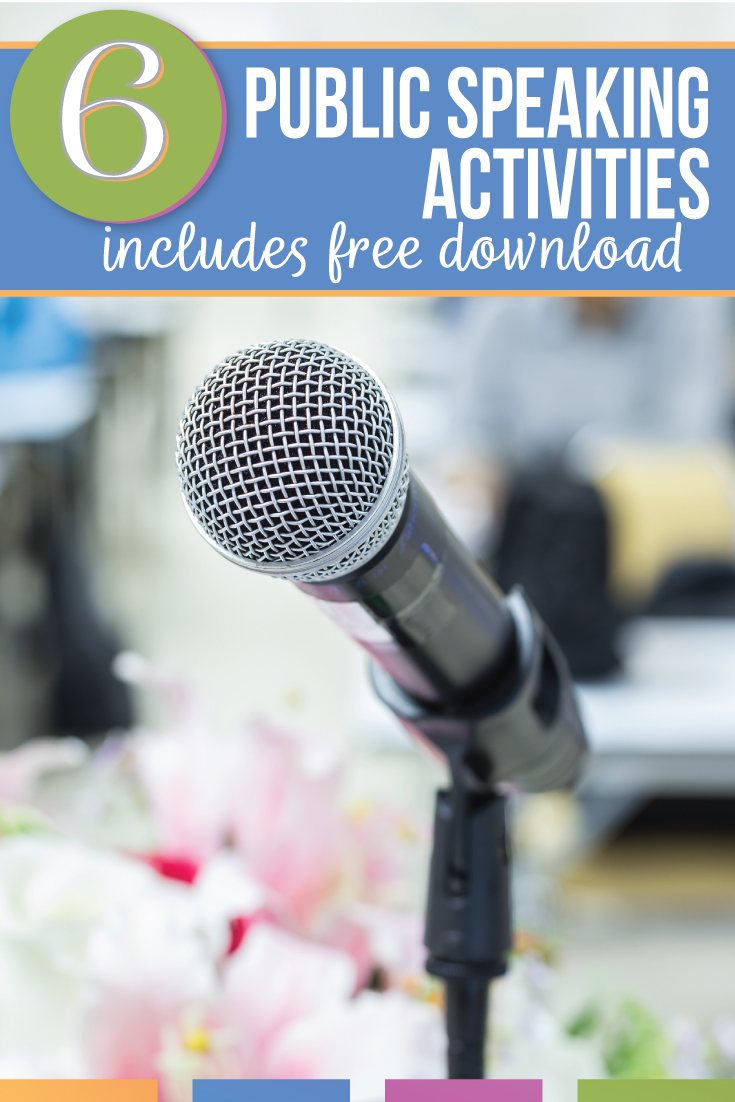
Public speaking activities can be engaging and memorable. Students might be nervous about giving speeches, so provide a variety of opportunities for them to practice. As you build a classroom community, these activities easily can become public speaking games.
Work on material slowly and purposefully. By helping students see success with public speaking, they will gain more confidence in your speech class and in life. Soon, your speech activities for high school students will be personalized and fit your community.
As you incorporate these public speaking games and activities into your speech units, you’ll discover that they are easily adaptable. Plus, you’ll find the perfect timing for each exercise. Teaching public speaking requires experimentation and reflection. I hope these help!
Would you like these public speaking activities at your fingertips? Download these six lesson plans (plus many more!) when you sign up for library access.
Subscribe to our mailing list to receive updates about new blog posts, freebies, and teaching resources!
Marketing Permissions We will send you emails, but we will never sell your address.
You can change your mind at any time by clicking the unsubscribe link in the footer of any email you receive from us, or by contacting us at [email protected] . We will treat your information with respect. For more information about our privacy practices please visit our website. By clicking below, you agree that we may process your information in accordance with these terms.
We use Mailchimp as our marketing platform. By clicking below to subscribe, you acknowledge that your information will be transferred to Mailchimp for processing. Learn more about Mailchimp’s privacy practices here.
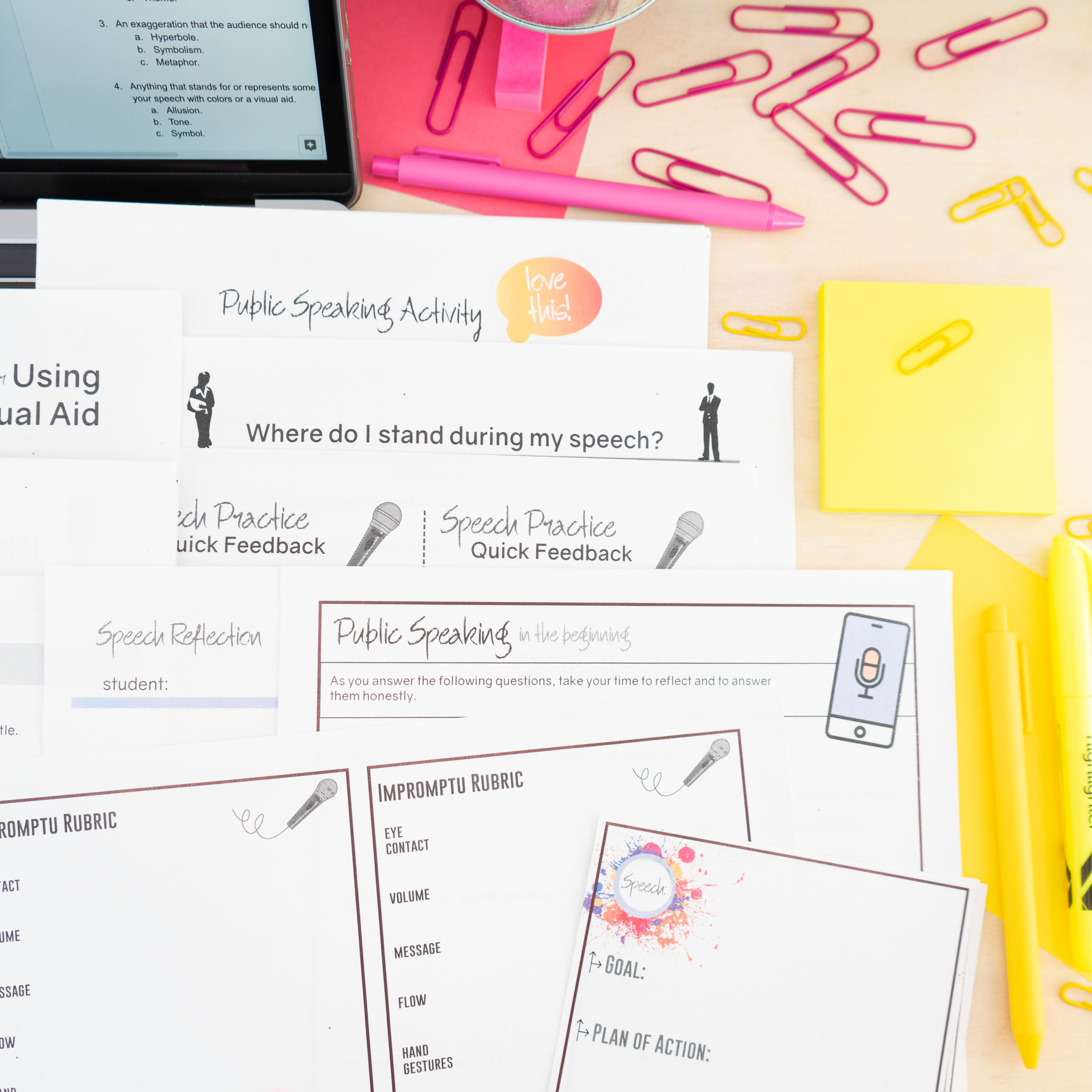
public speaking public speaking activities speech activities

Improve your practice.
Enhance your soft skills with a range of award-winning courses.
45 Public Speaking Topics and Ideas
October 4, 2018 - Helen Hooper
Do you enjoy standing up in front of a large audience and making a speech? Or do you get so nervous that you forget what you were going to tell the audience about?
If the answer to the second question is “yes,” then you’re not alone. Many people, including well-known entrepreneurs, politicians, and actors, aren’t fans of public speaking. For example, did you know that Richard Branson is among them? Yes, one of the best entrepreneurs in history has a real far of public speaking!
“I loathe making speeches, and always have,” Branson admitted in one of the interviews. “Over the years, however, I have become much more practiced at giving speeches, though it still makes me a bit nervous.”

“Fortunately, the fear of public speaking shouldn’t be an insurmountable obstacle for you with some learning and practice,” says Gordon Stevens, a motivational coach. “The more you develop your skills, the more confident you’ll feel during your speeches.”
Moreover, having strong public skills can greatly boost your career and improve your position in the labor market. Warren Buffet stated “you can improve your value by 50 percent just by learning communication skills – public speaking”
So, whether you’re looking for topics for your next public speech or just for practice, take a look at these 45 ideas, including tips on how to choose the best ones for your purpose.
Public speaking topics
Category: science.
1. Why humans should colonize mars
Let’s be honest here, humans are endangered species because all of us live only on one planet. Colonizing mars increases the chance of long-term survival of humankind and has many other benefits, so it’s definitely a great topic to talk about.
2. When will AI exceed human performance?
It’s one of the most discussed topics in science right now because AI has been developing at an amazing speed in the recent years. So, there are tons of quality materials to retrieve information from, such as this article from cornell university .
3. What is the future of commercial space flight?
Elon musk has recently announced the name of the first space tourist who will orbit the moon several times on SpaceX’s most advanced spacecraft, the BFR. When do you think this will happen?
4. Should nanotechnology research continue?
With all the risks and ethical issues that nanotechnology research is facing now, it could be an interesting topic to discuss.
5. Should we bring extinct species back from the dead?
Animal cloning is becoming more common, so cloning extinct species appears to be a matter of time. But should we really bring back animals like mammoths? What would we do with them if we succeed?
6. Potential for super greenhouse effect on earth
Global warming is the real thing, and governments around the world are starting to take this issue seriously. But where are we on our way to triggering a runaway greenhouse effect that turned our neighboring planet Venus into a hellish world?
7. What is gene therapy?
For example, could we use it to prevent diseases and conditions?
8. Why whales should not be hunted for food
Also an interesting topic that touches upon one of the most relevant issues in environmental health.
9. Stephen Hawking’s contributions to science
One of the greatest minds in history, Stephen Hawking, passed away recently, so it would be great to share his main contributions to science.
10. When will the next solar superflare hit earth?
The scientists know it’s coming, but can we make some predictions?
Category: self-development and self-help topics
11. How can you improve public speaking skills?
Why not, right?
12. What leadership style is the most suitable for your personality?
There are a number of leadership styles, so finding out which one suits you is an interesting idea.
13. How to get a fresh start after a breakup / divorce?
14. Why you should become a freelancer
15. Why being lazy isn’t always a bad thing
16. What Richard Branson recommends to everyone to make everyday a success
Here are some materials for you to start researching.
17. Why you should visit at least 5 countries by the time you’re 30
18. Gluten isn’t bad for health
19. Scientific evidence on why you shouldn’t skip your breakfast
20. Why success if often an extreme tolerance for failure (Jeff Bezos experience)
Jeff Bezos is an excellent example of a person who thinks of a failure as a chance to learn .
Category: society
21. Do professional athletes make too much money?
22. Why the your country should promote legal immigration
23. Is it possible to eliminate poverty in every country in the world?
24. The internet should be free for everyone
25. Why punishing children for bullying others isn’t a solution
This conversation article has some good ideas on that for you to explore.
26. The U.S. should encourage the spirit of volunteerism
27. Society should make monopolies illegal
28. Is our society too dependent on technology?
29. Why we need to support local businesses
30. Being gay: choice or nature?
31. Cell phone use while driving should be banned in all U.S. states.
Category: workplace
32. How to spot a toxic employee?
33. Give 5 reasons why we should abolish tipping restaurant servers
This Huffington Post article will be of great help to you on this topic.
34. Why the minimum wage should be raised?
35. Top reasons why best employees invest in employee wellness programs
36. The best ways to increase employee engagement for better performance
37. Should age discrimination be a criminal offence?
38. All internships should be paid internships
39. The minimum age for unsupervised driving should be raised to 18
40. LGBT workers are protected from workplace discrimination.
Category: controversial
41. Airline passengers should sacrifice their privacy for the sake of flight safety
42. Your government should promote conservation
43. Your government should make animal testing illegal
44. The use of the internet by teens should be limited
45. The internet contributes to media bias
How to choose a public speaking topic?
Check out these quick tips for picking a great topic:
- Choose a topic that you’re fairly familiar with or have an interest in. This might help you to include some personal experience as a bonus to your speech.
- Know your audience. Your topic should always resemble the interests of your audience, otherwise they could find it boring. In this case, you’ll be wasting yours and their time.
- Pick up a hot topic that describes a current event, place, or process.
Read this article for additional information on choosing a public speaking topic .
15 Fun Public Speaking Activities
Much like riding a bike public speaking is a skill that is best learned through practice. And what happens when we enjoy doing something that we do? We do it more often.
So here are 15 fun public speaking activities that you can do, either by yourself or with a group of people or if you are running a class you can use this using with your students as well. ( more public speaking activities here )
[youtube id=”4zRgNymCB7w” mode=”normal” align=”center”]

What Are The 15 Fun Public Speaking Activities?
I truly believe that making public speaking fun is one of the things that are going to take an average public speaker and give then enough practice to turn them into a good or great public speaker.
1. My Friend’s Fictional Life
In this activity, what you do is you get up in front of people (you can do it home by yourself as well) and you take one of your friends and you introduce them. However, instead of introducing them in the normal way you make up a fictional life for them.
So you say, hi this is Jane Smith, and she actually moonlights as a jazz pianist for the underground mafia. And you talk about her life, whatever it may be.
So this is fun because it makes you been creative, it’s very easy to think of these things on the spot and just roll with it. It’s generally pretty funny as well.
2. Impromtu Game
You basically just get up in front of people and somebody gives you something impromptu to run with.
It might be a topic, it might be a sentence or it might just be a single word or anything like that. But generally we run with just a certain topic.
For example: They need to talk about climate change or they need to talk about what makes a great teacher, or they need to talk about social media changes or whatever. So that the impromptu game.
3. Funny Image Game
This is similar to the impromptu game, but basically what you do is you give the speaker a funny image; you can find these easily just searching through Google and you get them to talk about that image.
You can pretend it’s their life experience and how this impacted my life or they can talk about why this image is important and what this image means or what’s the story behind this image.
4. Continuous Story
This is best done with a group of people. Each person gets up and might speak for anywhere from 20 seconds to a minute and they start telling a story.
And when their time is up, the next person has to get up and they have to continue the story.
So, obviously each person doesn’t know what the person before them is going to say and so they have to continue the story.
The goal of this is to make the story make sense. This game helps people engage in listening and learn to be creative enough to make the story continue on and make sense.
5. Something In My Wallet
You can use your own wallet or (if people are comfortable enough and happy to do it) you can get the person sitting next to you’s wallet.
Take an item out of the wallet and discuss what this item is and why its important and obviously you are trying to elaborate and make it funny as much as possible.
6. Action Story
This can be done in 2 ways.
A) You tell a story that has a whole great of actions in it and as a speaker you have to do these actions yourself whilst speaking.
B) Or the audience has to do the actions themselves while the speaker is giving their speech.
So you could say; I did a big stretch when I woke up in the morning. And everybody has to stretch. And then you say, I put on my hat, and everybody has to do the actions in line with that.
7. Make A Commercial
Get a bunch of things from your room or from your house, bring them in and you need to make a commercial about these items.
Someone is giving a random product. It might be a deodorant, might be an iphone, it could be anything. And then they are required to give a 30 second to 1 minute commercial on this product and talk about why this is so awesome and why people should buy it. So that’s a really fun one as well.
8. A Fake Holiday
This one is done with images primarily and a set of images that are related to each other.
So it could be a farm where you have images of animals, or the barn house or something funny happening on the farm.
The speaker is required to tell maybe 1, 2 or 3 sentences for each image and then you click forward to the next image.
Then they need to use the next image to continue the story.
So you are using these images as the key cards, as to where the story needs to go so the person needs to adapt the story based on the images that are given.
9. Alternative Ending
You take a well known TV show or a well-known movie. And what you do is you create an alternative ending for it.
10. Connect The Nouns

This is really a fun one, I really like this one.
You can do this by either putting nouns on key cards shuffling them up and picking 2 up at a time or you can use this random noun generator .
You get 2 nouns and you then have to create a story that connects that 2 nouns.
So it might be ‘a sheep’ and ‘a mechanic’ or it could be ‘friend’ and ‘shoelace’.
Then you have to create a story that connects those 2 nouns together.
11. How It Got It’s Name
Take an item (for example: packing tape) and you need to create a story around a packing tape and why it’s got its name that way.
You have to make it exciting.
12. Oink Substitution
When you are giving a speech you must allocate one word that you have to replace with word ‘oink’. Or you can use ‘moo’ or you use ‘woof’ or whatever it is that you want.
So you can use the word ‘I’ and replace it with ‘oink’.
So you would say: “Oink went to the movies and oink bought some popcorn.” And so you replace that word ‘I’ with ‘oink’.
This challenges your mind, and it makes that little bit harder to deliver a presentation. And it’s pretty funny for the audience, as well.
13. Which Is A Lie?

This one is generally pretty easy to out work and a lot of fun as well. And you will find that some students do it really well, but then some students just fumble when they are tying to lie and its quiet humorous to watch.
A person gets up and tells 3 truths about themselves, but 2 of them need to be true and one of them needs to be a lie .
So they get up and they tell 3 things about themselves and then the audience needs to choose which one was a lie and they see if they were correct.
So this one is really quick, really easy and you don’t have to go into a great detail about it but it can be really fun.
14. Definitions

Get really big words that nobody really knows what the meaning is. You can do this using this big word generator or another tool (just Google it). Or you can just go through the dictionary and pick some strange ones yourself.
The speaker has to get up – they are given this strange word and they need to with confidence tell the class what this word means.
Obviously they are making it up, but they need to do it confidently.
15. Endings
You give a person an ending. It could be a saying: “Diamonds are forever” or an ending to a story ‘and the man cried for 3 days’.
You give them an ending and they have to create a story that matches up with that ending.
A lot of being a great pubic speaking is about story telling. Teaching people how to creatively think up stories on the spot is going to make them a better public speaker.
I have previously talked about how public speaking rubric actually damages the progression of public speaking skills . We need to continually practicing public speaking (like riding a bike) and have it be fun if we want to teach people to be great public speakers . Technique comes along with that.
So keep that in mind, keep public speaking fun and I hope that you enjoyed these activities.
18 thoughts on “15 Fun Public Speaking Activities”
Great activities Ryan! Thank you for sharing. I will definitely be using these with my graduating seniors to help them write their speeches!
Thank you for uploading these activities, Ryan. I’ll be using it with my kids.
These are fun and practical. Thanks for sharing
Great Ideas Ryan. I am a public speaking trainer in Spain and ypur ideas helped me to mix up my classes and have some fun activities. Thanks.
Very nice activities and funny too! Shall use in my sessions with students.
These are activities are definitely doable and fun! I would love to try these with my Oral Comm students! Thank you!
This is a Supercalifragalistic piece. I already think this will work without having tried it, but I’ll definitely give it a shot. Thanks for the revelation Ryan
Great tips. I used some of them for my classes. Really enjoyed your video too! Well done!
Thank you for downloading these ideas. I will be using several of these for teaching a Speech Class. They will also be helpful for beginning Debate Class as well.
Good sharing. Im gonna use it for my pupils. Tq.
Pingback: November 13th | Meeting Agenda – Lee Early College Beta Club
Pingback: November 27th | General Meeting Agenda – Lee Early College Beta Club
Very practical, thank you for sharing! I will use most of them with young people with intellectual disabilities.
how these activities can lead the students to participate in big events in the school? thank you
Thank you for these wonderful suggestions. I will use them with my EAL students.
Thank you for sharing your great innovative ideas, we will definitely use for my students. THANKYOU
Leave a Comment Cancel Reply
Your email address will not be published. Required fields are marked *
This site uses Akismet to reduce spam. Learn how your comment data is processed .


ENG 131 Public Speaking
- Public Speaking
- Assignment Resources
- APA Citation Help
Assignment Resources Page
Use the tabs at the top of the box below to view resources on the various types of speeches.
Additional resources for public speaking are listed at the bottom of this page.
Types of Speeches
- Informative
- Process/Demonstration
- Inspirational/Ceremonial/Entertainment
- Topics for Informative Speeches
- Chapter 15: Informative Speaking Chapter 15 Informative Speaking In Public Speaking Lumen Learning. Authored by: Lisa Schreiber, Ph.D.. Provided by: Millersville University, Millersville, PA. Located at: http://publicspeakingproject.org/psvirtualtext.html. Project: Public Speaking Project. License: CC BY-NC-ND: Attribution-NonCommercial-NoDerivatives
- Informative Speaking Guide In this guide, you can learn about the purposes and types of informative speeches, about writing and delivering informative speeches, and about the parts of informative speeches.
Sample Speeches
- Topics for Persuasive Speeches
- The Tools of Persuasion: Ethos, Logos, & Pathos
- Applying Evidence in a Persuasive Speech
- Monroe's Motivated Sequence Video on Monroe's Motivated Sequence
- Topics for Process Speeches
- How to Master the Demonstration Speech How to give an outstanding demonstration speech.
- Elements of an Excellent Demonstration Speech Elements of an Excellent Demonstration Speech. Authored by: Phil Venditti. Provided by: Clover Park Technical College, Lakewood WA. License: CC BY: Attribution
- Demonstration Speech Topics - How To Choose
- 6 Inspiring Eulogy Examples to Draw From
- What is an Elevator Pitch? Examples for Students and Job Seekers
- Speaking to Entertain and for Special Occasions Chapter in Public Speaking text which Includes resources for a number of different occasions including eulogies, toasts and roasts. Why It Matters: Speaking to Entertain and for Special Occasions. Authored by: Misti Wills with Lumen Learning. License: CC BY: Attribution
Sample Inspirational Speeches
- Topics for Impromptu Speeches
- Impromptu Speaking Video from Toastmasters International that includes tips and techniques.
- Self-Introduction Tips and Tricks (with Examples)
- Introduction Speeches and More Step by step guides and examples to Introduction, with additional links on right of page to Farewell, Acceptance and Commemorative speeches and speech topics.
Additional Resources
- Great Speeches Video Series Clips and full speeches of influential leaders such as JFK, Malcolm X, FDR, Martin Luther King Jr. and others.
- The Art of Public Speaking Public speaking tips - video 3 mins
- Public Speaking Tip Sheets Tip Sheets developed by the University of North Carolina at Greensboro Speaking Center. Tips sheets can be viewed online or downloaded. Topics include delivery, types of speeches, and facilitation.
- How to Conquer the Fear of Public Speaking
- Six Minutes Speaking and Presentation Skills Articles on Speech Writing, Delivery Techniques, PowerPoint & Visuals, Speaker Habits, Speaker Resources & more.
- Principles of Public Speaking Online Course In Principles of Public Speaking, students learn how to prepare and deliver effective oral presentations, with an emphasis on informative and persuasive public speaking. The course introduces important elements of successful presentations including effective listening, presentation organization, and logical structure; informative and persuasive speech; use of visual aids, research, and evidence; ethical considerations; and techniques for building confidence in public speaking.
- Exploring Public Speaking: 4th Edition Open textbook shared under license CC BY NC SA. more... less... Tucker, Barbara; Barton, Kristin; Burger, Amy; Drye, Jerry; Hunsicker, Cathy; Mendes, Amy; and LeHew, Matthew, "Exploring Public Speaking: 4th Edition" (2019). Communication Open Textbooks. 1. https://oer.galileo.usg.edu/communication-textbooks/1
- << Previous: Public Speaking
- Next: APA Citation Help >>
- Last Updated: May 10, 2023 2:45 PM
- Guide URL: https://libguides.wilmu.edu/ENG131

My Speech Class
Public Speaking Tips & Speech Topics
Narrative Speech [With Topics and Examples]

Jim Peterson has over 20 years experience on speech writing. He wrote over 300 free speech topic ideas and how-to guides for any kind of public speaking and speech writing assignments at My Speech Class.
Narrative Speech Topics

- Your Events, Life Lessons, Personal Experiences, Rituals and Your Identity.
The main point is that you are talking about yourself.
Your thoughts, feelings, ideas, views, opinions and events are the leading ladies in this special public speaking speech writing process.
In this article:
Your Life Lessons
Experiences, narrative speech writing tips, 10 fast showcases.
Here are example narrative speech topics you can share in a speech class or other public speaking assignment in high school, college education. Narrow the speech topics appropriately to the public speaking occasion rules with the specialized checklist I have composed with seven narrative speech writing tips .
The checks and tips also serve as hooks for to narrate a paragraph in an college essay.
Can We Write Your Speech?
Get your audience blown away with help from a professional speechwriter. Free proofreading and copy-editing included.
The backbone of my advice is: try to keep the story devoted and dedicated. If you find it hard to develop speech topics for narration purposes and you are a little bit overwhelmed, then try ten ways I’ve developed to find narrative speech topics .
Most students mark out an event in their speeches and essays. An event that stipulate a great step in life or an important moment that has impact on your prosperity or lifestyle from that particular period:
E.g. An accident or remarkable positive event that changed my life. The birth of my brother, sister or other relative and the impact on our household and family-life. My first day at high school or college. The decision I regret most at my school or in my professional job career. My day of graduation (If you have not yet graduated from an educational institution, describe your hardworking and your planning efforts to achieve the qualification). My first serious date with my boyfriend / girlfriend. A significant family event in the summer. A memorable vacation. A historical event that impressed me. The day I will move overseas. A milestone that seemed bad but turned out to be good. My heroic sports moment at the campus field.
Take personal growth and development as starting point. Widen the horizon of the audience to a greater extent with narrative speech topics on wisdom. Construct a life lesson yourself, based on a practical wisdom acquired by own experience, or one you have been be introduced to by someone else:
E.g. The influence of a special person on my behavior. How I have dealed with a difficult situation. What lessons I have learned through studying the genealogy of my family. A prejudice that involved me. An Eureka moment: you suddenly understood how something works in life you had been struggling with earlier. How you helped someonelse and what you learned from her or him, and from the situation.
For this kind of public speaking training begin with mentioning intuitively the emotions you feel (in senses and mind) and the greater perception of the circumstances that lead to apprehension of a precarious situation:
E.g. My most frustrating moment. How you handled in an emergency situation. How I break up with my love. A narrow escape. A moment when you did something that took a lot of courage. A time when you choose to go your own way and did not follow the crowd. How I stood up for my beliefs. The day you rebelled with a decision concerning you. How you cope with your nerves recently – think about fear of public speaking and how you mastered and controlled it in the end. What happened when you had a disagreement with your teacher or instructor in class, this triggering narrative speech idea is great for speech class, because everyone will recognize the situation.
This theoretic method is close related to the previous tips. However, there is one small but significant difference.
Let’s define rituals as a system of prescribed procedures or actions of a group to which you belong. In that case you have the perfect starters to speak out feelings .
Complement the ritual with your own feelings and random thoughts that bubble up when you are practicing the ritual:
E.g. How you usually prepare for a test at high school or for a personality interview or questionnaire. Your ritual before a sports game. Your ritual before going out with friends – make up codes, choosing your dress or outfit, total party looks. The routines you always follow under certain circumstances on your way to home. Church or other religious rituals you think are important to celebrate. Special meditative techniques you have learned from old masters in East Asia.
These examples are meant to accent the cultural and personal charateristics based on values, beliefs and principles.
What do you think is making life worth living? What shaped your personality? What are the psychological factors and environmental influences?
And state why and how you ground your decisions:
E.g. My act of heroism. The decisions my parents made for me when I was young – school choice, admission and finance. How curiosity brings me where I am now. I daydream of … A place that stands for my romantic moments – a table for two in a restaurant with a great view. My pet resembles my personal habits. A vivid childhood memory in which you can see how I would develop myself in the next ten to fifteen years. Samples of self-reliance in difficult conditions, empathy towards others in society, and your learning attitude and the learning curve.
Make a point by building to a climax at the end of your speech topic, whatever the narrative speech topics may be you want to apply in some sort of public speaking training environment. Build your way to the most intense point in the development or resolution of the subject you have chosen – culminate all facts as narrator to that end point in your verbal account.
Narrative speech tips for organizing and delivering a written description of past events, a story, lesson, moral, personal characteristic or experience you want to share.
- Select carefully the things you want to convey with your audience. Perhaps your public speaking assignment have a time limit. Check that out, and stick to it.This will force you to pick out one single significant story about yourself.And that is easier than you think when you take a closer look at my easy ways to find narrative topics.
- What do you want your audience to remember after the lapse?
- What is the special purpose, the breaking point, the ultimate goal, the smart lesson or the mysterious plot?
- Develop all the action and rising drama you need to visualize the plot of the story: the main events, leading character roles, the most relevant details, and write it in a sequence of steps. Translate those steps into dialogues.
- Organize all the text to speech in a strictly time ordered format. Make a story sequence. Relate a progression of events in a chronologically way.The audience will recognize this simple what I call a What Happened Speech Writing Outline, and can fully understand your goal. Another benefit: you will remember your key ideas better.It can help if you make a simple storyboard – arrange a series of pictures of the action scenes.
- Build in transition sentences, words or phrases, like the words then, after that, next, at this moment, etc. It helps to make a natural flow in your text.
- Rehearse your narrative speech in front of a friend and ask opinions. Practice and practice again. And return to my narrative speech topics gallore if you get lost in your efforts.Avoid to memorize your text to speech. When you are able to tell it in a reasonably extemp manner – everyone can follow you easily – it is okay.
- Finally, try to make eye contact with your listeners when you deliver this educational speech and apply my public speaking tips one by one of course.
- A good place to start finding a suitable narrative speech topic is brainstorming about a memorable moments in your life, a situation you had to cope with in your environment, a difficult setting or funny scene you had to talk your way out.
Try to catch it in one phrase: At X-mas I … and followed by a catchy anf active verb.
E.g. At X-mas I think … I want … I’m going … I was … I stated … I saw … .
After the task verb you can fill in every personal experience you want to share with your public speaking audience in a narration. These 40 speech topics for a storytelling structure can trigger your imagination further.
My most important advice is: stay close to yourself, open all your senses: sight, hearing, taste, and even smell and touch. Good for descibing the memorable moment, the intensity of it.
- A second way to dig up a narrative speech topic is thinking about a leading prophetic or predictive incident in the previous 10 years or in your chidhood. Something that illustrates very well why and how you became who you are right now.
E.g. Your character, moral beliefs, unorthodox manner of behaving or acting or you fight for freedom by not conforming to rules, special skills and qualities.
- The third way I like to communicate here with you is storytelling. Let yourself be triggered for a narrative speech story by incidents or a series of events behind a personal photograph or a video for example.
E.g. Creative writing on a photo of your grand-grandparents, of a pet, a horse, an exciting graduation party, a great architectural design.
- You also can find anecdotal or fictional storylines by highlighting a few of your typical behavior or human characteristics.
E.g. Are you a person that absorbs and acquires information and knowledge, likes to entertain other people or nothing at all? Or are you intellectually very capable in solving comprehensive mathematical calculations? Or are you just enjoying life as it is, and somewhat a live fast die young type?
Or a born organizer – than write speech topics about the last high school or college meeting you controlled and administered.
- The fifth method I would like to discuss is the like or not and why technique. Mark something you absolutely dislike or hate and announce in firm spoken language (still be polite) why. A narrative speech topic based on this procedure are giving insight in the way you look at things and what your references are in life.
It’s a bit like you make a comparison, but the difference is that you strongly defend your personal taste as narrator. It has a solid persuasive taste:
E.g. Speeches about drilling for oil in environmental not secure regions, for or against a Hollywood or Bollywood movie celebrity, our bankingsystem that runs out of trust of you the simple bank account consumer. Or your favorite television sitcom series.
- An exciting, interesting, inspiring or funny experience or event that changed your life is the next public speaking tip I like to reveal now.
E.g.? Staying weekends at your uncle’s farm shaped you as the hardworking person you are nowadays. A narrative speech topic in this category could also be about music lessons, practical jokes. Or troublesome events like divorce, or great adventures like trips at the ocean. Or even finding faith or a wedding happiness.
And what do you think of extreme sports tournaments?
- An important lesson you learned from someone you admire. This is a very classical narrative speech topic.
It tends to be a little bit philosophical, but if you tell you story people will recognize what you mean and compare that with their own stories and wisdom lessons.
Tell the story of a survivor of a traffic accident, and how you admire her or his recovery. Winners of awards, great songwriters, novelists, sportsheroes.
This list is almost exhaustive. Share the wisdom of their fails and achievements.
- The moment in your life you see the light, or that was very insightful. It seems a bit like my number six advice, but focus more on the greatness and happiness of that very moment. A moment’s insight is sometimes worth a life’s experience, American Judge Oliver Wendell Holmes have said.
Magnificent and breath-taking nature phenomenons, precious moments after a day of struggle, final decisions that replenish, lift your spirit.
- A fable or myth that has a moral lesson you try to live to.
Aesop Fables are a great source for a narrative speech topic idea structure. Think about The Dog and His Reflection, The Fox and The Grapes, and Belling the Cat. Talking about fairy tales as an inspiring source: what do you think of a personal story about the moral of The Emperor’s New Clothes?
- The relation between a brief series of important milestones in your life that mold your character is also possible – if catchy narrated storytelling of course :-).
First day of school, first kiss, Prom Night, your high school graduation, wedding, first job interview.
Christening Speeches
Pet Peeve Speech Topics
Leave a Comment
I accept the Privacy Policy
Reach out to us for sponsorship opportunities
Vivamus integer non suscipit taciti mus etiam at primis tempor sagittis euismod libero facilisi.
© 2024 My Speech Class
Chapter 4 Giving Your First Speech

Students also viewed
CMST100--Introduction to Public Speaking Assignment Page
First Policy Speech
- Time--6-8 Minutes
- Value: 10% of final grade
- Required--Typed outline with bib page, mini-dvd r, feedback sheet.
- Sources--Minimum of ten (ask me about appropriate evidence).
- Approval--by me, the Friday before the speech.
- Note--if you use note cards, they can only contain key words or quotations.
Assignment --For your first speech, I would like you to choose a topic (one that you care about) and persuade this audience to support a public policy--a policy you will delineate in detail showing how , and that , it will work. Topics can vary widely, but the thesis must be a policy statement. Topics can include, but should not be limited to, politics ("We should support a particular national health care program"), environmental issues ("We should charge a tax to all home owners who produce more than two standard sized trash cans of garbage per week"), or military issues ("There should be a hard date by which all U.S. troops will be withdrawn from Iraq"). My only requirements are that the topics must be ones that both the speaker and the audience care about and ones that the audience needs to be persuaded on (i.e., do not attempt to get your audience to support a policy they already support). Because I have a good deal of experience from past classes knowing what topics work and what topics do not, and because I want to be sure that you are speaking on a policy, you are required to approve your topic with me by Friday, July 13. Failure to do so will meet with a "0" for this assignment.
Because we will have only discussed disposition and invention by the time of your speech, this is primarily what you will be judged on (that, and the delivery, which we will take more seriously with each round of speeches).
Evaluation :
- --did the speaker provide a clear and obvious thesis statement?
- --did the speaker establish ethos, reveal the topic, gain the audience's attention and preview the route of the speech?
- --were the forms of evidence and resources varied and plentiful?
- --did the speaker cite sources in the spoken effort and the outline, and were these citations non-obtrusive?
- --was need clearly understood by the audience?
- --did the speaker adequately satisfy the problem presented?
- --were transitions clear and abundant?
- --did the speaker summarize the main points and come to a clear close?
- --did the speaker "know" the audience to the degree that examples, wording, and arguments were "fitted" to this particular audience/occasion?
- --did the speaker reasonably meet time limits?
- --did the speaker sound like an "automaton" or did s/he appear to be in conversation with the audience?
- --was the outline clear and adequate?
If you need help, please either come by my office, call me (322-2988) or email me.
Return to CMST100 course page or my homepage .
Second Policy Speech
- Value: 15% of final grade
- Required--Typed outline with bib page (if you had problems with your first outline, see me), mini-dvd r, feedback sheet.
- Sources--Minimum of ten, four different forms (ask me about appropriate evidence).
Assignment --Again, I would like you to choose a topic (again, one that you care about) and persuade this audience to support a public policy--a policy you will delineate in detail showing how , and that , it will work. Topics can vary widely, but the thesis must be a policy statement. Topics can include, but should not be limited to, politics ("We should support a particular national health care program,"), environmental issues ("We should charge a tax to all home owners who produce more than two standard sized trash cans of garbage per week"), or military issues ("Gays should be allowed to serve in the US military"). My only requirements are that the topics must be ones that both the speaker and the audience care about and ones that the audience needs to be persuaded on (i.e., do not attempt to get your audience to support a policy they already support). Because I have a good deal of experience from past classes knowing what topics work and what topics do not, and because I want to be sure that you are speaking on a policy, you are required to approve your topic with me by July 20. Failure to do so will meet with a "0" for this assignment.
- --organization: is the speech organized well in the outline? Does the speech appear organized as delivered? Was the audience confused or did they understand the effort?
- --outline: does it fit the requirements? Does it show evidence of a well thought out plan of action?
- --delivery: Simply put, does the delivery detract from the message or add to it? (Did you create a climate in which conversation with the audience would be possible?)
- --style: Were relevant words chosen? Did the speaker utilize discourse that detracted from, or added to, the message?
- --policy: Did the speaker clearly point out the problems (need), note the way in which the policy satisfies the need (and refute opposition to it), show that it will indeed work, and clearly explain the policy?
- --Be sure to choose a topic you feel some degree of passion about.
- --Spend time researching, researching, researching.
- --Try different approaches out on friends, getting honest and descriptive feedback.
- --Make sure you are not "reading" the effort by utilizing only key word outlines. Remember, the same speech should never be given twice.
- --Be willing to pay attention to your audience, to emphasize points that need extra emphasis, to slow down when the audience is confused. Let the audience dictate how the speech works "in practice."
- --Reflect on the audience's reactions to your last speech and work those into this one.
- --Talk to me about this one as often as necessary.
Interactive Policy
- Time--8 Minutes speaking time; 7 minutes of criticism.
- Value: 20% of final gade
- Required--Typed outline with bib page, mini dvd-r, feedback sheet.
- Approval--by me, at least one week before the day you speak.
Assignment --This effort will again center on your provision and support for a public policy, albeit one different from the last round of speeches. Each of you should have a better idea of what I mean when I am asking for a specific policy and should be prepared this time to present a speech that clearly identifies a problem and then satisfies it by showing how a specific policy, if implemented, could solve this problem. Your outline should clearly illustrate the harms, inherency, solvency, etc. even though you will probably not be able to deliver all of the material you prepare.
The difference in this speech and the last one lies in your interaction with the audience. After it is clear that you have presented your thesis (MAKE THIS VERY CLEAR), the audience is allowed to ask you questions about a claim you have made or offer counterarguments to one of your arguments. Your task as a speaker is to either answer each question at the time it is raised or to judiciously defer the response. At 7 minutes, 30 seconds, a timer will warn you that you have 30 seconds remaining. At this point, no one will be allowed to ask questions, and you must bring your speech to a smooth conclusion, no matter how far through the body of the "planned" speech you are at the time. Hence, the trick is to be able to stay on track, answer questions politely and still persuade the audience of the value of your policy within the allotted time.
- --YOU WILL JUDGED ON BOTH YOU PLAN IN THE OUTLINE AND WHAT YOU ARE ACTUALLY ABLE TO DELIVER IN THE TIME ALLOTTED.
Contemporary Issue
- Time--6-8 Minutes speaking time.
- Value: 30% of final grade
- Approval--by me, by the Friday you speak.
Assignment --This speech is meant to show your ability to construct a reasonable policy on an issue and represent the collective interests of a group (rather than an expression of your interests alone). In short, after our class chooses a topic, you will either choose a group or be assigned to one and will represent its interests throughout this round of speeches.
For example, let's say the class chose to discuss the current military situation in Iraq from a global perspective. Each person in the class would then be "hired" to speak in the interests of one of a variety of groups or individuals. The class would have spokespersons for President Bush, the Democratic Party, the current Iraqi government, the U.N. chief, heads of other nation-states. Your job is to create a policy that represents the interests of the group you are "hired" to represent and to speak in their interests throughout the round of speeches. Topics and the past have varied from international issues (e.g., global policies toward terrorism, the Israel-Palestine question), national political issues (e.g., legalization of drugs), ethical questions (e.g., genetic engineering), and questions of sports (e.g., how to carry out Title IX). The topic choice should reflect this class' interests. The group you choose to represent should be a group that you would choose to work for "in real life."
In this round of speeches, the feedback session will be waived in favor of a question-answer period. That is, each speaker will be given 15 minutes to speak and respond to questions posed by the audience. The speech should not go longer than 8 minutes with the time remaining spent answering questions from the audience. While you may speak as long as you want up to 15 minutes, I suggest you leave at least 7 minutes for questions as one portion of your grade will come from your ability to respond to questions. Each of you will maintain your representative role throughout the round and hence will both ask and answer questions from the perspective of the group you represent. Remember, no one would hire you to sit quietly and not represent their interests, so speak up whenever your group would have something to say on an issue.
Your evaluation this time will be derived from three areas:
- the speech itself.
- your ability to answer questions from the perspective of the group you represent.
- your ability and willingness to ask questions in an attempt to protect the interests of your perspective (the evaluation of your speech and ability to answer questions can be raised or lowered up to a full letter grade contingent upon this third category).
- Research your group (its history, interests, positions on other policies, etc.) thoroughly before you begin researching the policy itself. Remember, you are to represent this group's interests and have been hired to speak for them in a public forum. Hence, you must know what they would say.
- Speak firmly on your position as if it were your own (e.g., don't say, "Well, I don't really believe this but Clinton would say . . . "
- Rehearse the speech well enough to leave time for questions. You do not want to lose points on your evaluation simply because you were not ale to respond to questions. You may want to set up hand signals with one of your classmates to make sure you do not speak over an allotted amount of time.
- Have questions prepared for other speakers as this is part of your evaluation. The class should NEVER want for discussion during this round.
- Prepare the speech just often enough that you can deliver it with a sense of freshness and spontaneity. Be willing to clarify, to leave your plan, if the situation calls for it.
- While each of us will always speak for a "foreign" interest (be it Iraq or Wyoming), let's not take our arguments personally. Put descriptive feedback into action as an "idea" even while we discuss policy. Remember, we speak to the policy, not the person.
Critiques/Attendance/Discussion Grade
As you can see, 25% of your final evaluation derives from a number of sources: your self evaluations (must be turned in at the class following your speech), your attendance and your ability to help your classmates through discussion of their efforts. I take this portion of your evaluation very seriously . What I expect in order for you to receive the full 25% will be perfect attendance when others are speaking (or, if you must miss class on a day when your classmates speak, you can attend another section of public speaking when the students in that class are speaking), a perfect record of turning in assignments, and a healthy attempt to add your voice to discussions. IF YOU MISS EVEN ONE CLASS WHEN OTHERS ARE SPEAKING AND DO NOT MAKE IT UP, YOU WILL LOSE THE ENTIRE 25% (with every absence thereafter resulting in the loss of an additional 10% of your final grade). There are no "excused absences" when others are speaking; you must make up such missed classes regardless of the reason (e.g., going on a University sponsored trip does not excuse you from making up that class meeting).
We will try to cultivate an environment in which everyone feels comfortable speaking. However, it is up to you to manifest the tendency to speak up in class. I do not want you to speak for the sake of speaking but instead want you to speak with thought and allow space for those who generally do not talk to feel comfortable speaking up. If you have any question about this portion of your evaluation at any point in the semester, you may ask for an evaluation from me in person.
Money Report

Warren Buffett says this public speaking class changed his life—4 tips from the course
By megan sauer,cnbc and marguerite ward,cnbc • published june 9, 2024 • updated on june 9, 2024 at 8:09 am.
Every year, before the Berkshire Hathaway shareholders meeting, hundreds of people line up outside the CHI Health Center Arena in Omaha, Nebraska, to hear Warren Buffett speak.
Some people come for investing tips . Others crave Buffett's life advice , as CNBC Make It reported last month.
Streaming 24/7: Watch NBC 5 local news and weather for free wherever you are
But despite his reputation, Buffett wasn't always a natural orator. The thought of public speaking made him "physically ill," and he specifically chose college courses to avoid talking in front of a class, he told author Gillian Zoe Segal in an interview for her 2015 book, "Getting There: A Book of Mentors."
After graduating from Columbia Business School in 1951, Buffett became determined to overcome his fear. He enrolled in a $100 public speaking course at Dale Carnegie Training , an institute named for the influential speaker and author of "How to Win Friends and Influence People" and other bestsellers.
Get DFW local news, weather forecasts and entertainment stories to your inbox. Sign up for NBC DFW newsletters .
DON'T MISS: The ultimate guide to becoming a master communicator and public speaker
"[The class] certainly had the biggest impact in terms of my subsequent success," Buffett told Segal. "A relatively modest improvement [in your communication skills] can make a major difference in your future earning power, as well as in many other aspects of your life."
Professionals can still benefit from the lessons Buffett used in that public speaking course, Dale Carnegie CEO Joe Hart told CNBC in 2019. Here are some of the more effective ways to become a better communicator:

Biden and Trump both want to extend tax cuts for most Americans — but paying for it could be tricky

OpenAI ex-employees worry about company's control over their millions of dollars in shares
Learn as much as you can.
Carnegie himself once wrote : "Talk about something that you know and know that you know. Don't spend ten minutes or ten hours preparing a talk: Spend ten weeks or ten months. Better still, spend ten years."
Being an "active learner" like Buffett is important for public speaking for a number of reasons, Hart said: It can help broaden, and deepen, your knowledge on a variety of subjects.
"It's something that's made him very successful," Hart added.
Talk about your own experiences
Making a speech personal is the shortest route to winning people over, Carnegie wrote. Buffett often does this in his talks, adding anecdotes from his life and career to make a point.
"Carry a sheet of paper with you for a few weeks and write down, as you think of them, all the subjects that you are prepared to talk about through experience," Carnegie suggested.
Jot down notes, not a draft
When Buffett speaks, he rarely looks at notes: One of Carnegie's core principles is that a good speech is never fully transcribed beforehand.
Refer to brief notes, Carnegie suggested, because reading from a script can keep you from being present.
"When you stand up to talk, you will probably find yourself trying to remember what you wrote," he wrote. "That will keep you from speaking naturally and with sparkle."
Get excited about the topic
Smiling, having "positive energy" and exuding confidence make a huge difference, said Hart.
Buffett became passionate about investing, money and achieving success at a young age. That enduring enthusiasm comes through in his speeches and interviews.
As Carnegie put it: "Even people with only mediocre speaking ability may make superb talks if they will speak about something that has deeply stirred them."
Want to be a successful, confident communicator? Take CNBC's new online course Become an Effective Communicator: Master Public Speaking . We'll teach you how to speak clearly and confidently, calm your nerves, what to say and not say, and body language techniques to make a great first impression. Sign up today and use code EARLYBIRD for an introductory discount of 30% off through July 10, 2024.
Plus, sign up for CNBC Make It's newsletter to get tips and tricks for success at work, with money and in life.
Also on CNBC
- 92-year-old just became one of America's richest self-made women
- Mark Cuban: How I turned 91% of my employees into millionaires when I sold a company
- Bill Gates calls this book a 'must read'—here are its top 3 takeaways

This article tagged under:
for Education
- Google Classroom
- Google Workspace Admin
- Google Cloud
Where teaching and learning come together
Google Classroom helps educators create engaging learning experiences they can personalize, manage, and measure. Part of Google Workspace for Education, it empowers educators to enhance their impact and prepare students for the future.
- Contact sales
- Sign in to Classroom
150M people worldwide use Google Classroom
Google Classroom is designed with feedback from the educational community, influencing the development of new features that let educators focus on teaching and students focus on learning.
Enrich and personalize learning
Drive student agency with tools that meet students where they are – and build skills for their future.
Premium features that inspire new ways of teaching and learning
Power student potential.
Create interactive assignments, even from existing PDFs, that provide real-time feedback and individual guidance with prompts and hints with the help of AI.
Help students develop literacy skills
Assign differentiated reading activities using the Classroom integration with Read Along, a fun, speech-based tool from Google that helps students independently build their reading skills, while giving educators insight into their progress.
Reinforce concepts with self-paced learning
Assign interactive questions for YouTube videos, giving students real-time feedback as they move through a lesson, while viewing insights into their performance.
Enhance lessons with popular integrations
Easily find, add, use and grade content with add-ons from popular EdTech tools, right within Classroom.
Make learning more personal and foster student agency
Support differentiated instruction.
Customize classwork for every student and support them with real-time feedback and easy communication tools.
Foster academic integrity
Encourage original thinking and identify potential plagiarism with originality reports that compare student work against billions of web pages and over 40 million books.
Make learning accessible and inclusive
Help students customize their learning environment to reduce barriers to learning.
Prepare students for the future
Encourage organization and time management skills with interactive to-do lists, automatic due dates, and industry-leading productivity tools.
- Explore all features
Amplify instruction with tools that simplify everyday tasks
Boost instructional time with tools purpose-built for teaching, productivity, and collaboration.
Premium features that elevate teaching
Support originality with plagiarism detection.
Help students integrate citations and avoid unintentional plagiarism with unlimited originality reports and a school-owned repository of past work.
Streamline lesson planning
Create a link to your class, then share it with peers in your organization, so they can easily preview, select, and import high-quality classwork into their classes.
Inform instruction with data-driven insights
Classroom analytics provide educators with insights and visibility into how students turn in, perform on, and engage with assignments, so educators can make informed decisions about the best way to provide support.
Simplify and connect grading workflows
Sync gradebooks to seamlessly manage and export grades from Classroom to your school’s SIS – available for PowerSchool (coming soon), Infinite Campus, Skyward SMS, Skyward Qmlativ, and Follett Aspen. Educators can customize grading periods (e.g., quarters, semesters, terms) and grading scales (e.g., letter, numeric) in their class settings to align to their school’s grading structure or system, reduce errors for SIS grade export and allow educators to more easily filter and analyze assignments.
Tools designed for seamless teaching
Save time on everyday tasks.
Assign, grade, and provide feedback across multiple classes, and even on the go with iOS and Android versions of the Classroom app.
Elevate communication, collaboration, and connection
Connect with students and parents instantly with embedded chat and meeting tools while leveraging built-in chat and comment features to leave students feedback as they’re working.
Grade more efficiently
Assess student progress with customizable rubrics that students can see, and save time with efficient feedback and grade export tools.
Get creative with hundreds of apps
Hundreds of EdTech apps integrate with Classroom to spark creativity and enable more opportunities for learning.
Operate with solutions designed to gain visibility, insights, and control
Create learning environments that are easier to manage and support educators and students with connected, safer tools.
Premium features to support your organization and foster stronger learning outcomes
Make data-driven decisions.
Gain visibility into everything from class performance to individual student assignment completion with Classroom analytics (coming soon), or export Classroom logs to BigQuery to analyze adoption, engagement, and more.
Distribute high-quality class templates to educators
Easily share high-quality class templates so educators in your organization can preview and import classwork into their own classes.
Virtually visit classes to support teachers and students
Designated education leaders and staff can temporarily access classes to support educators, manage substitute teachers, see information for guardian conversations, and more.
Manage classes at scale
Create classes automatically and sync class lists from your student information system (SIS) with Clever .
A secure, reliable, and extensible platform for school communities of all sizes
Benefit from industry-leading privacy and security.
Classroom uses the same infrastructure as other Google Workspace products, meeting rigorous privacy standards with regular third-party audits. Access a centralized Admin console with controlled entry and insights into performance and security.
Stay flexible and reliable
Scale your school community with a global network with full-stack security and 99% uptime.
Extend and scale Classroom
Integrate with your student information system (SIS) and customize Classroom to work for your unique needs with APIs.
Support staff and enhance collaboration
Empower educators with instructional resources , professional development programs , and online training courses , available at no cost.
Level up your Classroom with apps
Discover a world of apps that seamlessly integrate with Chromebooks and Google Workspace for Education.
- Explore App Hub
How Classroom can make a difference for you
Education leaders, it administrators.
Classroom can be learned in minutes and serves all types of learners and educators, regardless of their tech savviness. Empower educators, and encourage adoption and proficiency with new tools and techniques, with a broad range of resources.
- Get a quick overview of the benefits of Classroom
- Read customer stories
- Explore trainings and resources for educators
- 40+ ways to use Google Workspace for Education paid editions
- Learn about sustainability in Google for Education products
Teachers can immediately set up classes, easily create coursework, distribute it to the whole class, and grade it efficiently and transparently.
- Find an educator community
- Download the Classroom user guide
- View product guides
Admins have as much control as they need while they access and analyze their data for insights and choose from a range of upgrade options for additional capabilities to fit their specific needs.
- Get started with the paid editions of Workspace for Education
- View product demos
- Explore 40+ ways to use Google Workspace for Education paid editions
- Learn more about Google for Education security and privacy
- Guardian's Guide to Google Classroom
Need more information about Classroom?
- Visit the Help Center
Bring all of your tools together with Google Workspace for Education
Google Workspace for Education empowers your school community with easy-to-use tools that elevate teaching, learning, collaboration, and productivity – all on one secure platform.
- Explore Google Workspace for Education
150 million users
Active around the world, ready to transform your school, you're now viewing content for a different region..
For content more relevant to your region, we suggest:
Sign up here for updates, insights, resources, and more.

IMAGES
VIDEO
COMMENTS
There are several assignments for Principles of Public Speaking. If you import this course into your learning management system (Blackboard, Canvas, etc.), the assignments will automatically be loaded into the assignment tool. ... Attending a Speech Outside of Class. Analyze the speech for invention, arrangement, style, memory, and delivery.
There are solo as well as group activities. 3. For and Against. 'For and Against' encourages flexibility: the ability to see a topic from opposing sides. A speaker has 30 seconds to talk 'for' a topic and then another 30 seconds to speak 'against' it. Prepare and print out a selection of controversial speech topics.
Presentational speaking assignments encourage students to understand course material well enough to communicate it to others. Typically, these assignments emphasize factors such as: research, analysis, evaluation of data. adaptation of materials to meet the demands of the occasion and audience. determination of a suitable purpose and focus for ...
Persuasive Speech Assignment. An assignment that helps students artfully convince an audience. Students will be given the opportunity to persuade audience members that a policy should be started, changed, or stopped, and/or urge cooperation by asking them to performs specific tasks. Persuasion. by Scott Tulloch.
13. A False Vacation. This activity for public speaking is mostly made up of one photo or a collection of similar photographs. It can be a farmhouse where you see pictures of animals, the barn, or anything amusing. You must provide one, two, or three phrases for every picture before moving to the following one.
Topic Assignment: A moderator provides a topic, and the speaker has one minute to discuss it. Rules: Avoid hesitation, repetition, or deviation from the topic. ... College Public Speaking Courses: College public speaking courses are an excellent starting point for students eager to develop their speaking skills. These courses typically provide ...
30 Seconds Filler-Free. Filler words like "uh" "um" and "y'know" not only make your talk more difficult to listen to, but they also make you seem less prepared and authoritative. For this exercise, record yourself giving a talk on any topic for 30 seconds, taking care to omit all filler words.
This course is part of the Dynamic Public Speaking Specialization. When you enroll in this course, you'll also be enrolled in this Specialization. Learn new concepts from industry experts. Gain a foundational understanding of a subject or tool. Develop job-relevant skills with hands-on projects.
I never plan on this nonverbal practice becoming a public speaking game, but it often does. 3. One goal. Speeches can overwhelm students. Help students focus on one goal. The best part about the "one goal" activity is that students choose their focus which creates less work for you and buy-in for students.
24. The internet should be free for everyone. 25. Why punishing children for bullying others isn't a solution. This conversation article has some good ideas on that for you to explore. 26. The U.S. should encourage the spirit of volunteerism. 27. Society should make monopolies illegal.
The purpose of this assignment is to improve your ability to critique public speaking. Based on the class assignments thus far (graded and ungraded), in 1-2 pages in narrative form (not as bullet-points) assess EACH of your team members individually in terms of their strengths and weaknesses as public speakers.
Apply the solution: Instructional presentation • 60 minutes. 1 discussion prompt • Total 10 minutes. Reflect on the solution: Preparing an informative lecture • 10 minutes. 3 plugins • Total 27 minutes. Preparing an informative lecture: Causes and resources • 5 minutes.
6. Action Story. This can be done in 2 ways. A) You tell a story that has a whole great of actions in it and as a speaker you have to do these actions yourself whilst speaking. B) Or the audience has to do the actions themselves while the speaker is giving their speech.
* Your outline needs to follow the format discussed in class. Bring two copies of your outline on the assigned speaking day. One copy is for the instructor. Time Limit: 2-4 minutes Expectations for the speech: * Your speech meets the time limit. * Your outline meets the format requirements. * Your speech reflects the outline.
Public Speaking; Assignment Resources; APA Citation Help; Assignment Resources Page. ... In Principles of Public Speaking, students learn how to prepare and deliver effective oral presentations, with an emphasis on informative and persuasive public speaking. The course introduces important elements of successful presentations including ...
Narrative Speech Topics. Narrative speech topics list with public speaking ideas for a storytelling training I have categorized them in: Your Events, Life Lessons, Personal Experiences, Rituals and Your Identity. The main point is that you are talking about yourself. Your thoughts, feelings, ideas, views, opinions and events are the leading ...
The Art of Public Speaking-13th Edition Learn with flashcards, games, and more — for free. ... What are reasons that an ice breaker speech is often the first assignment in a public speaking class? Because professors want to get students up in front of the class as soon as possible Because much of the anxiety associated with public speaking is ...
CMST100--Introduction to Public Speaking Assignment Page. First Policy Speech. Time--6-8 Minutes. Value: 10% of final grade. Required--Typed outline with bib page, mini-dvd r, feedback sheet. Sources--Minimum of ten (ask me about appropriate evidence). Approval--by me, the Friday before the speech. Note--if you use note cards, they can only ...
Class Presentation by Students describes classroom presentations, offering suggestions for both faculty (for developing a speaking assignment) and students (for per-forming a speaking assignment). Public speaking is a learned skill. To speak well requires practice. Find (and make!) opportunities to speak in public.The ability to speak
The thought of public speaking made him "physically ill," and he specifically chose college courses to avoid talking in front of a class, he told author Gillian Zoe Segal in an interview for her ...
Warren Buffett says this public speaking class changed his life—4 tips from the course. Warren Buffett's Berkshire Hathaway raised its stakes in Mitsubishi Corp., Mitsui & Co., Itochu ...
Help students develop literacy skills. Assign differentiated reading activities using the Classroom integration with Read Along, a fun, speech-based tool from Google that helps students independently build their reading skills, while giving educators insight into their progress. Express interest in the early access program.